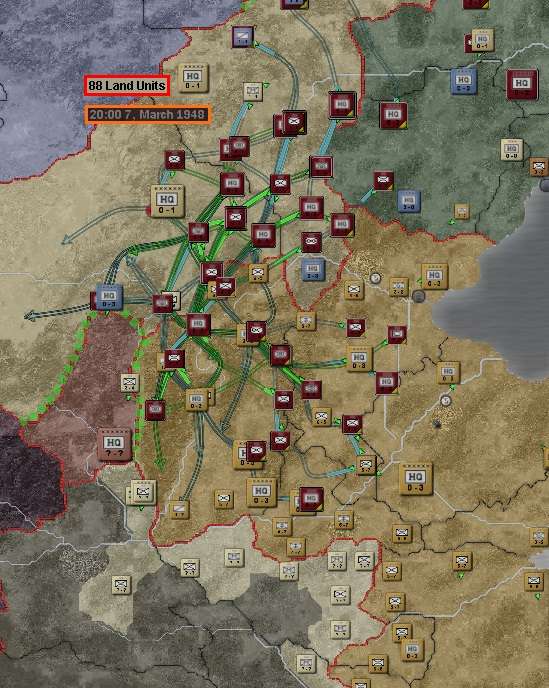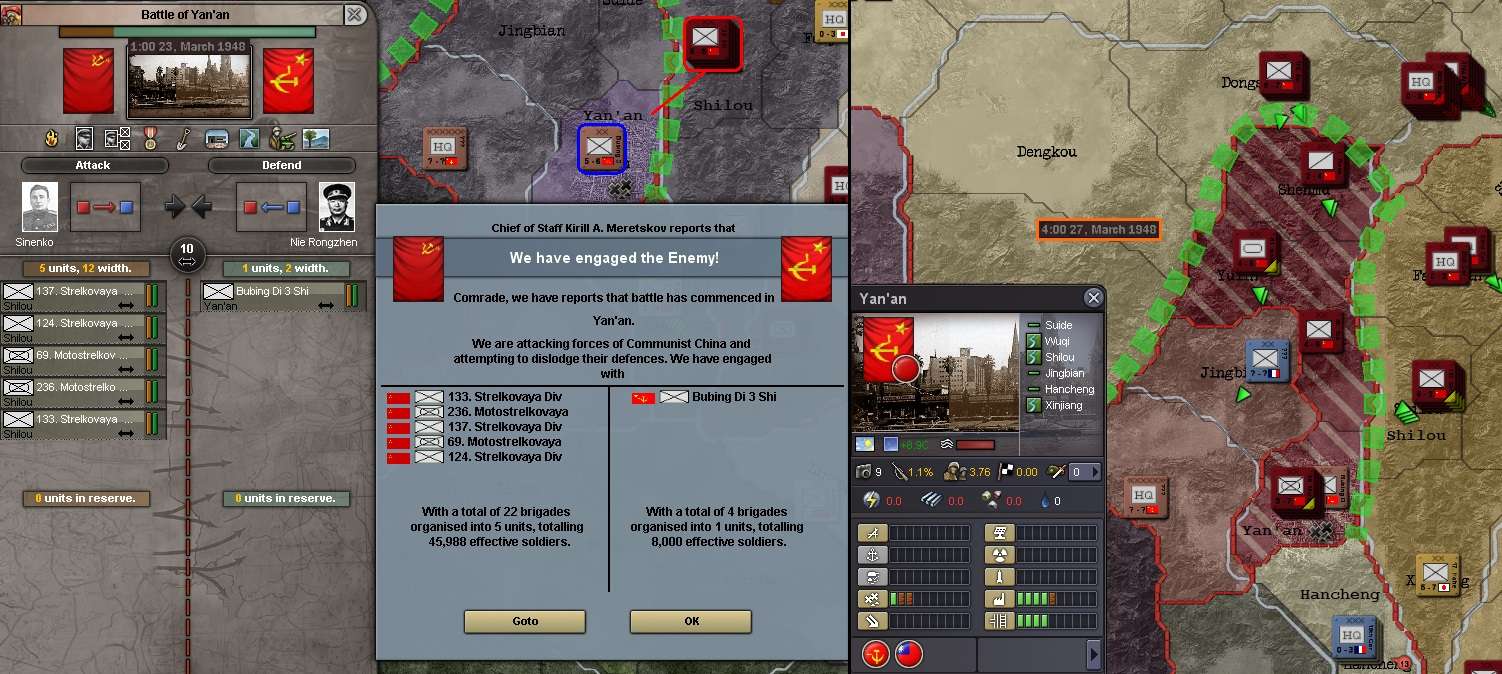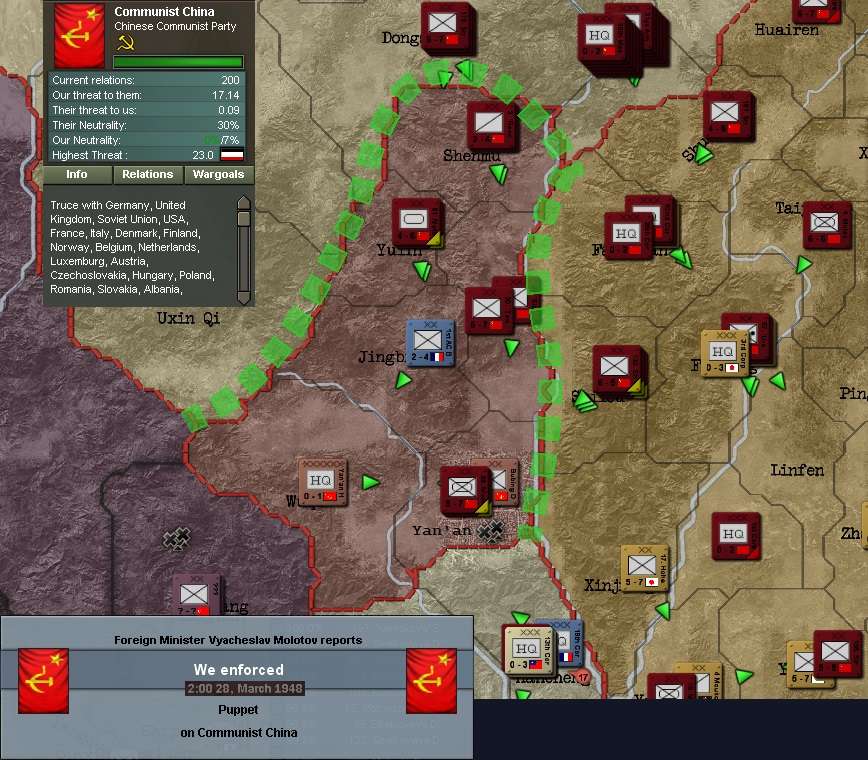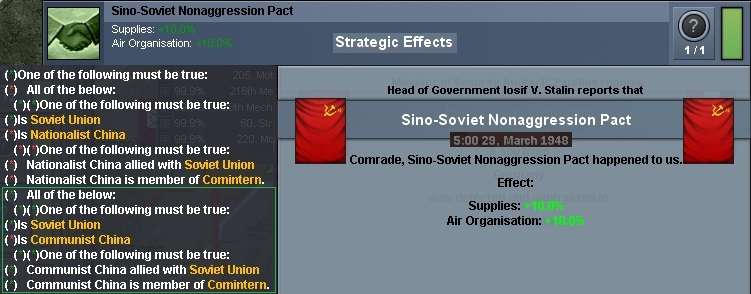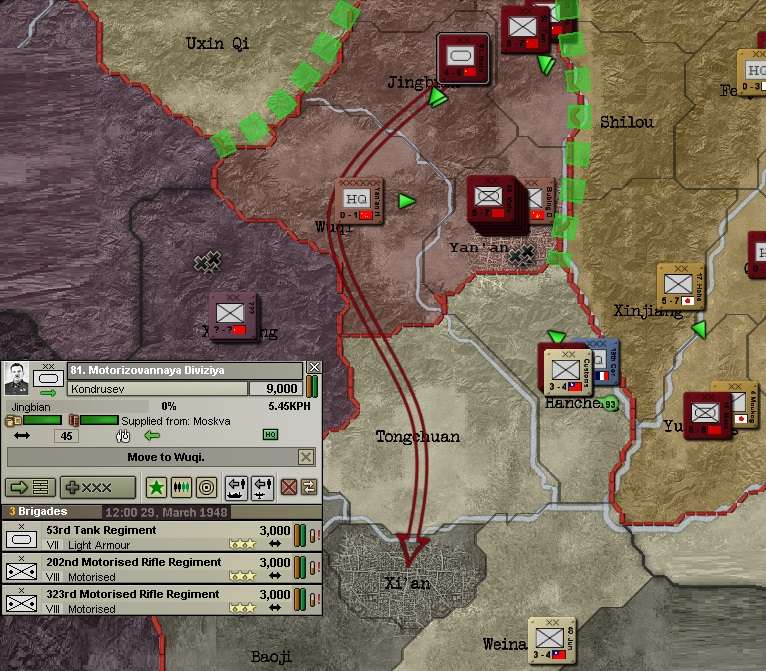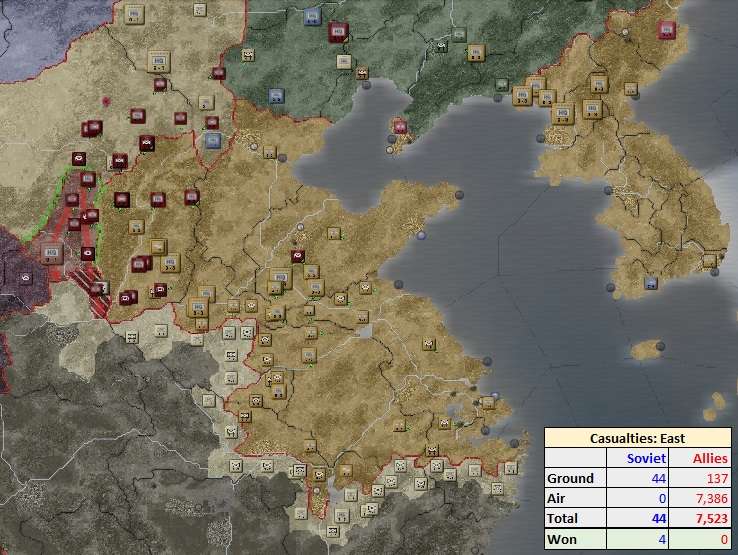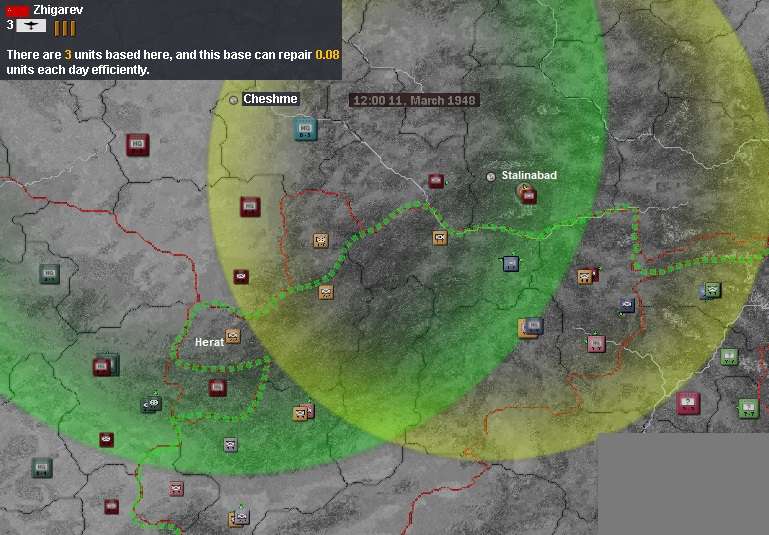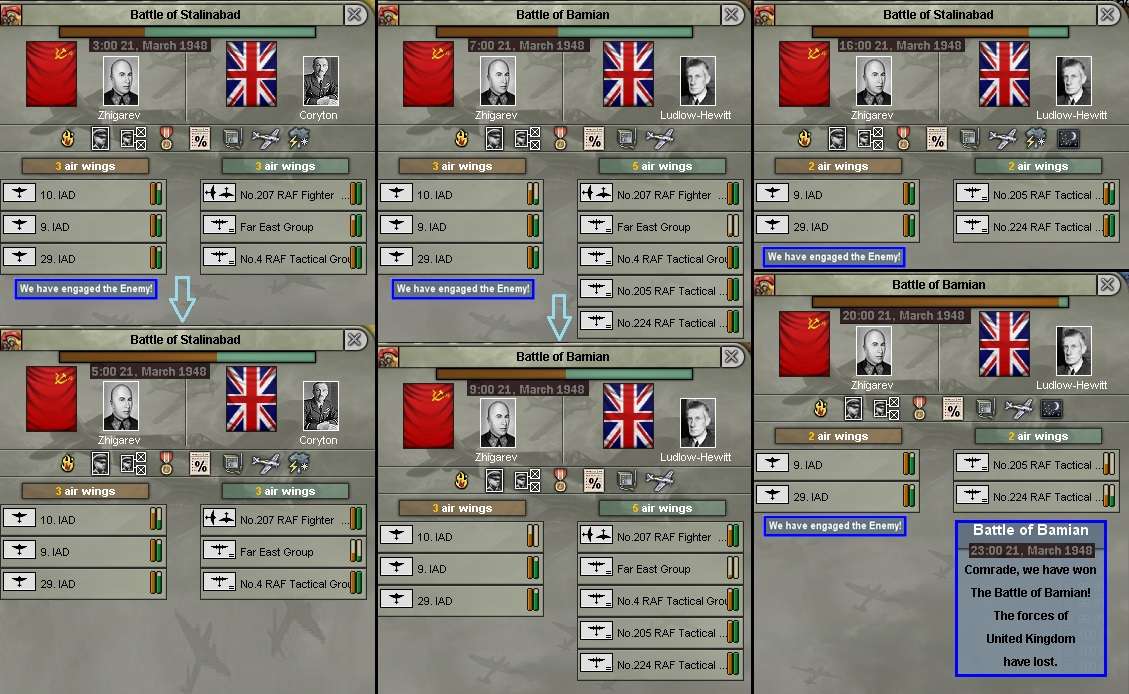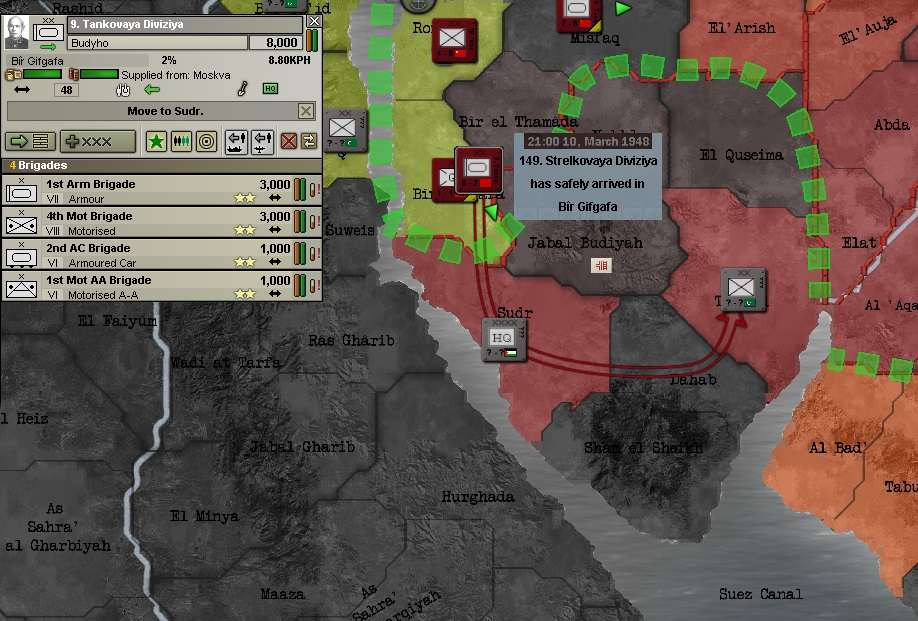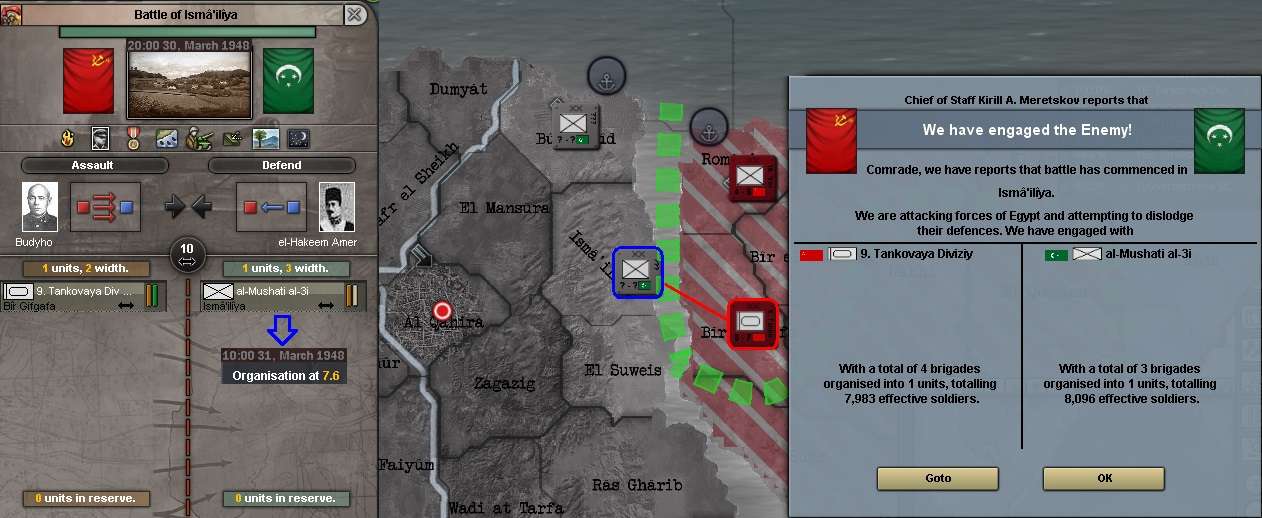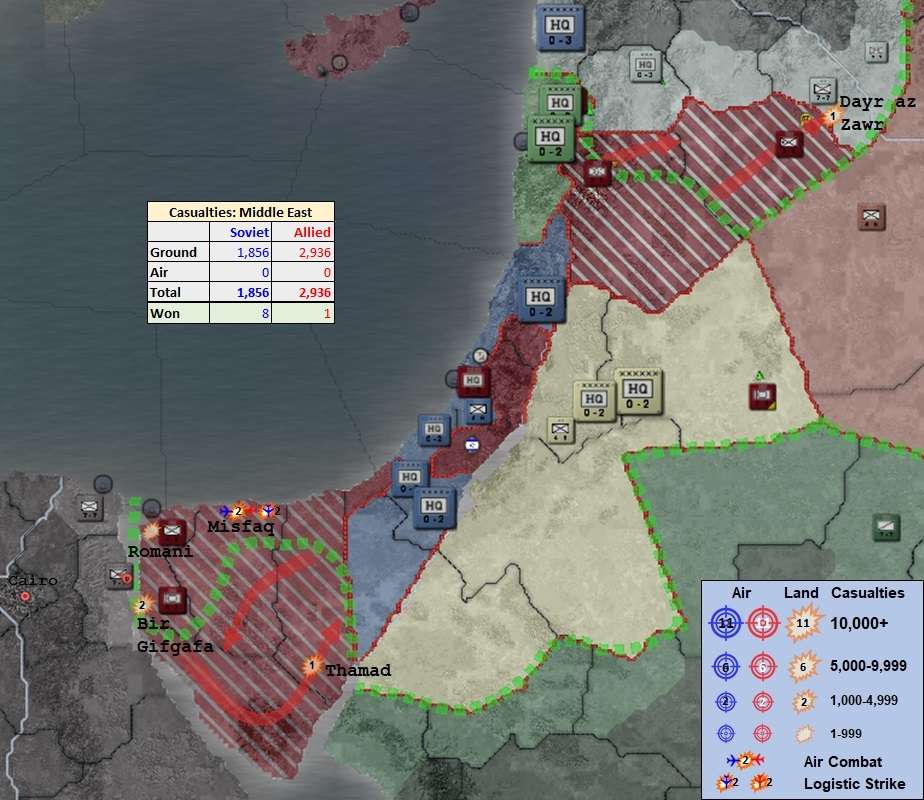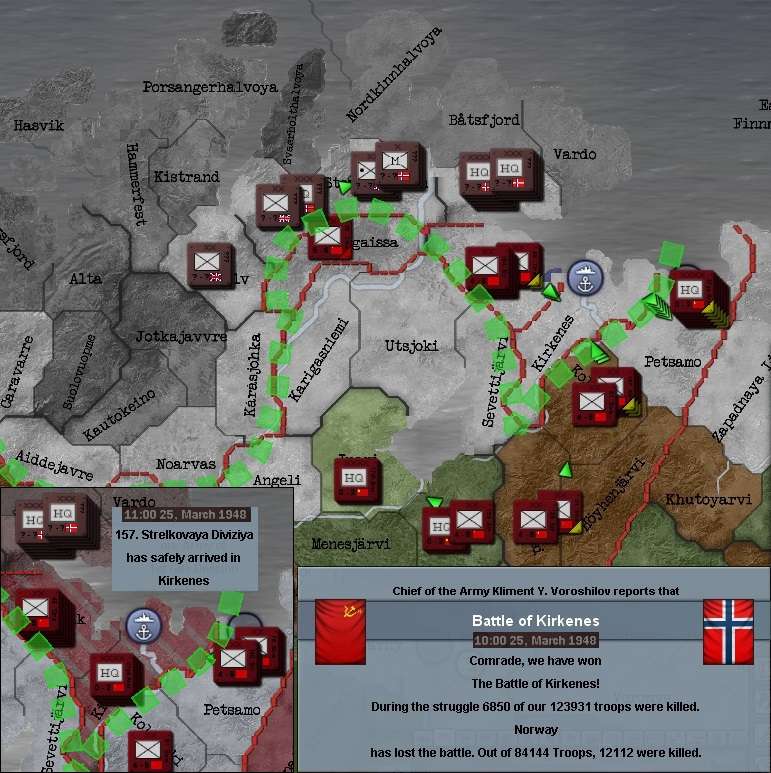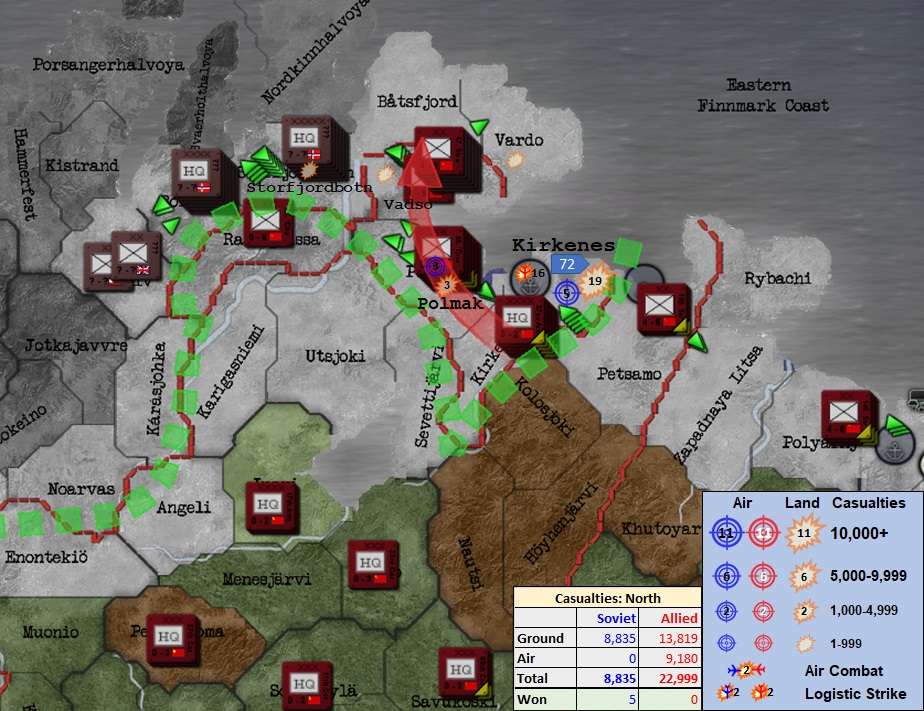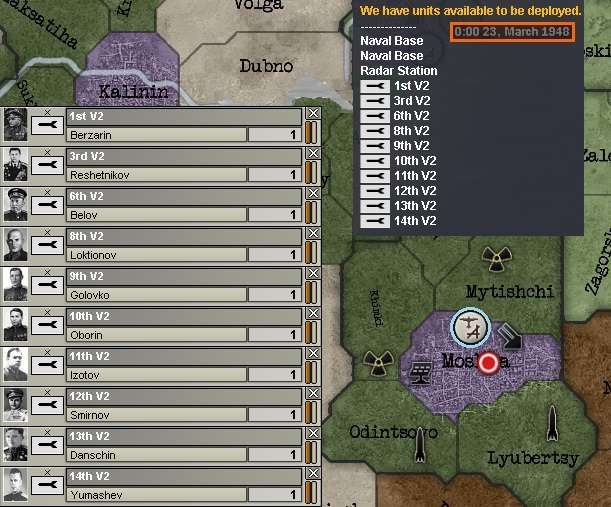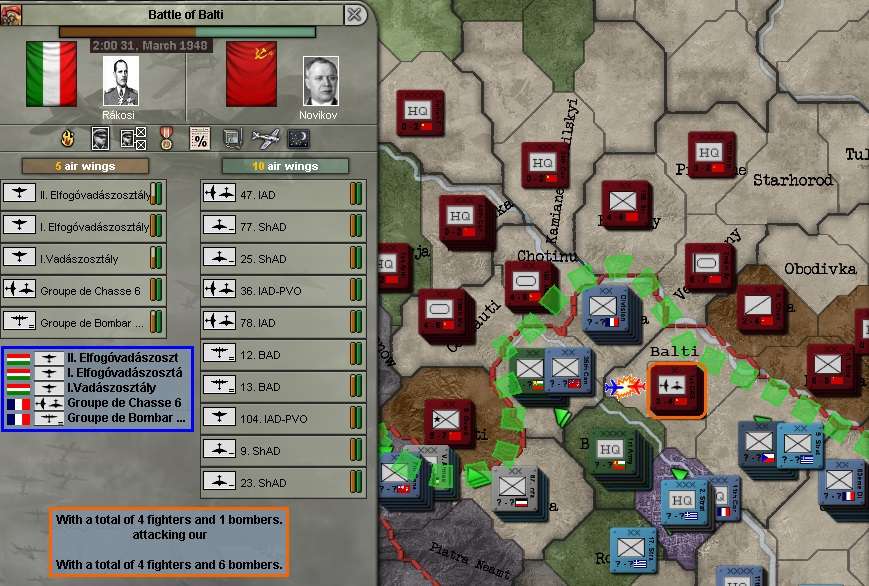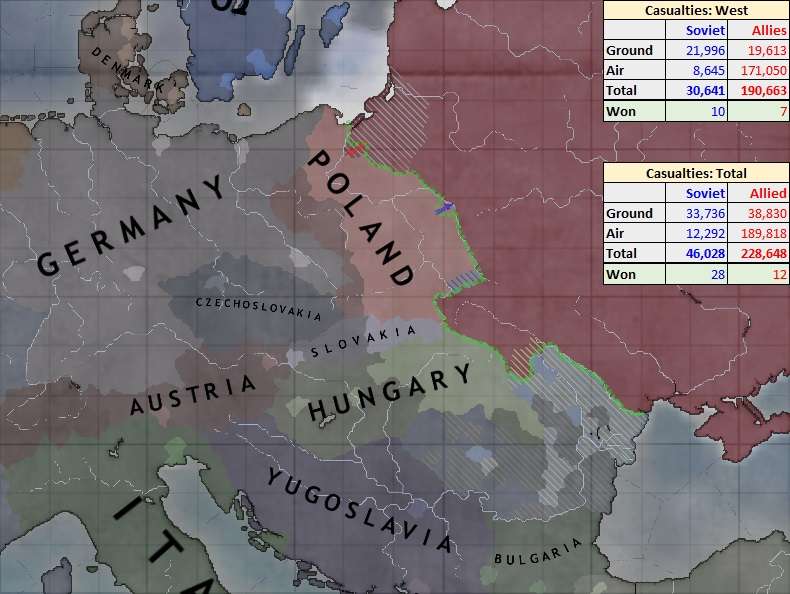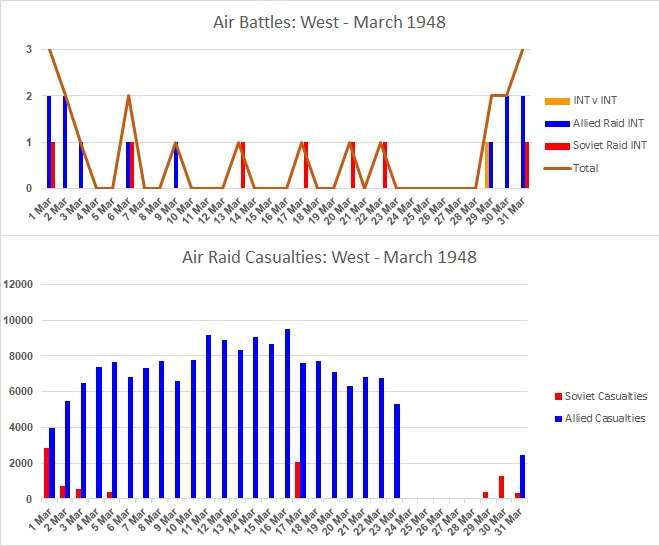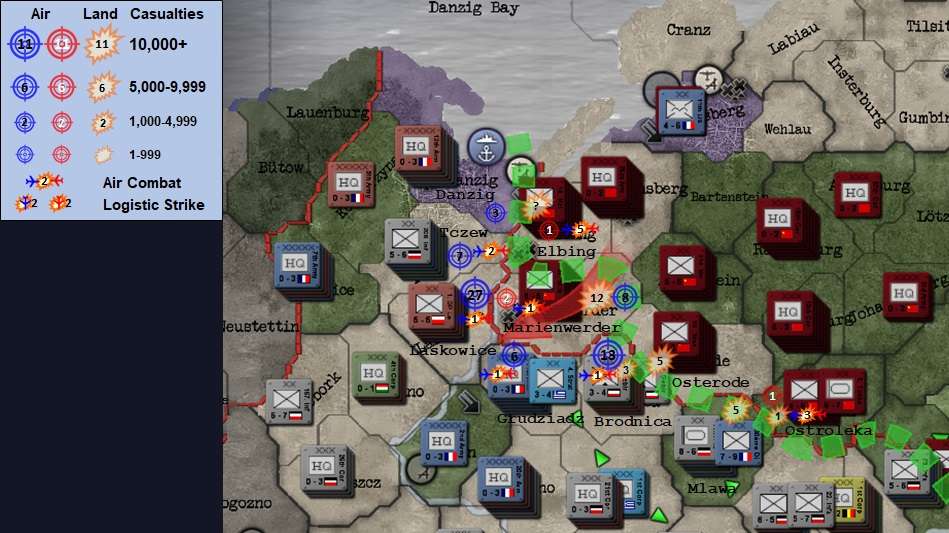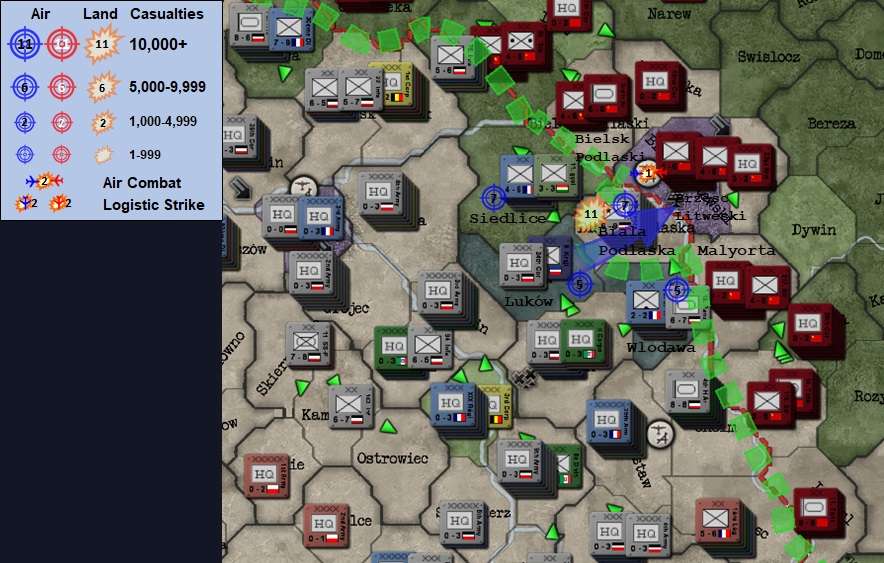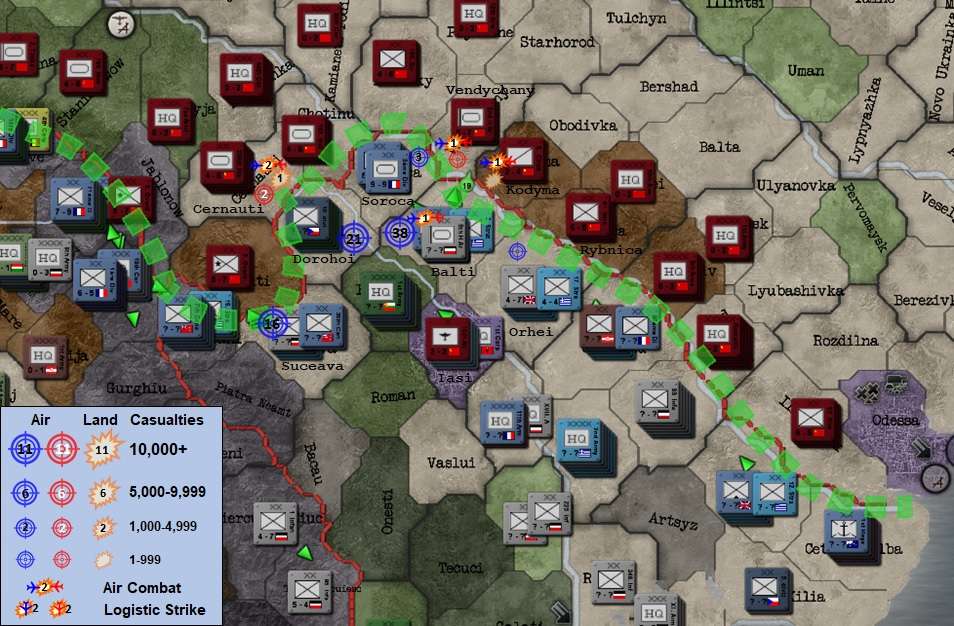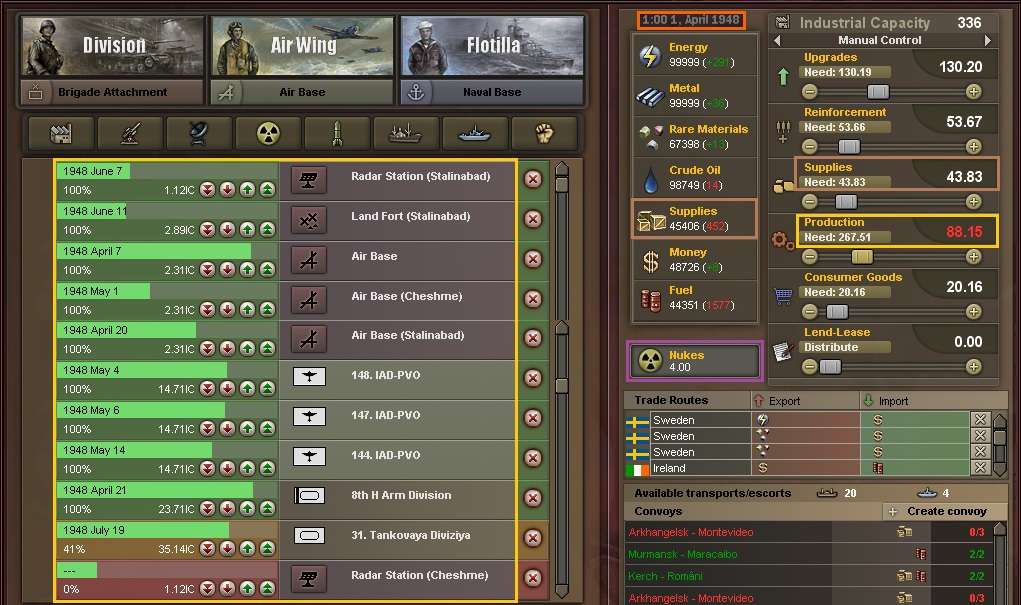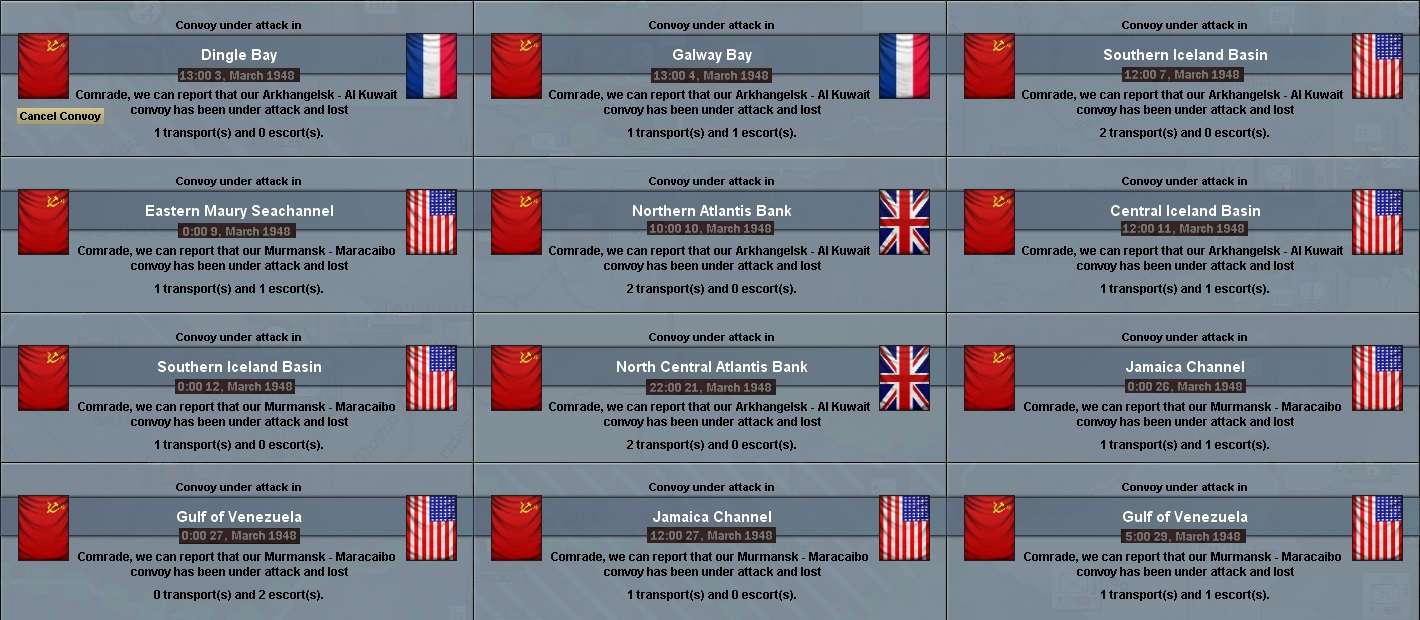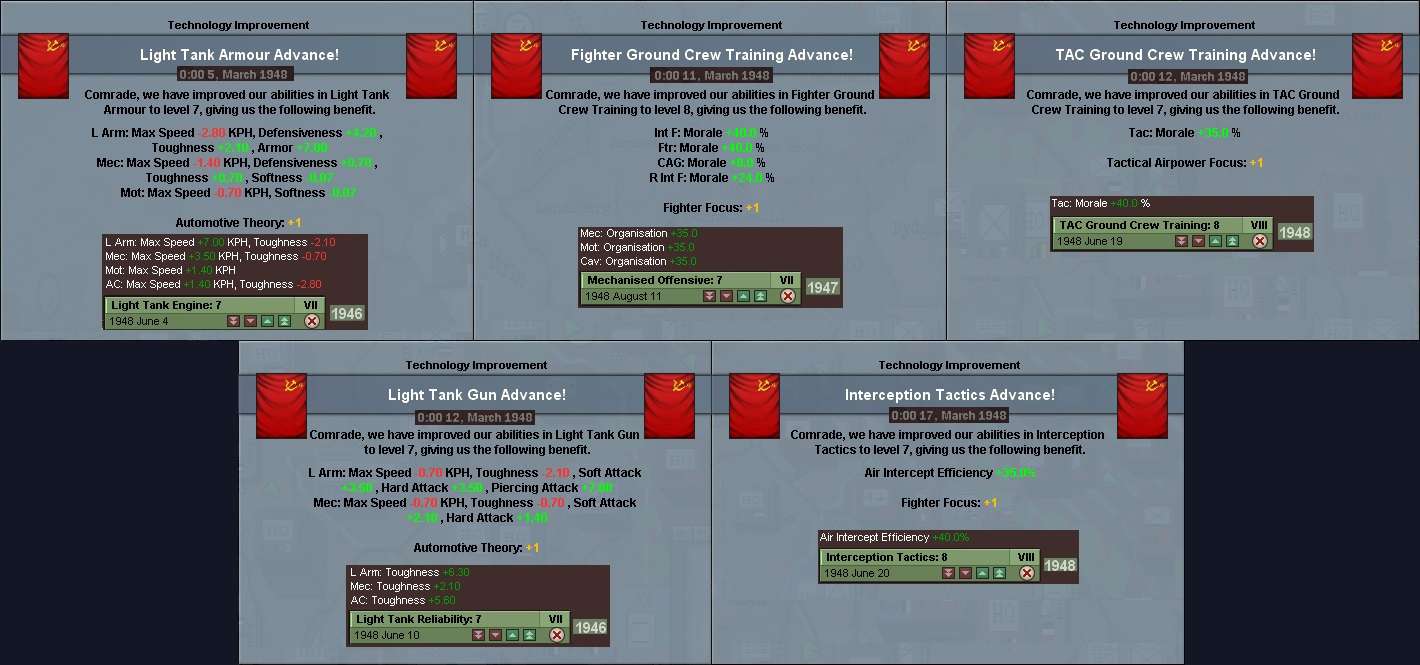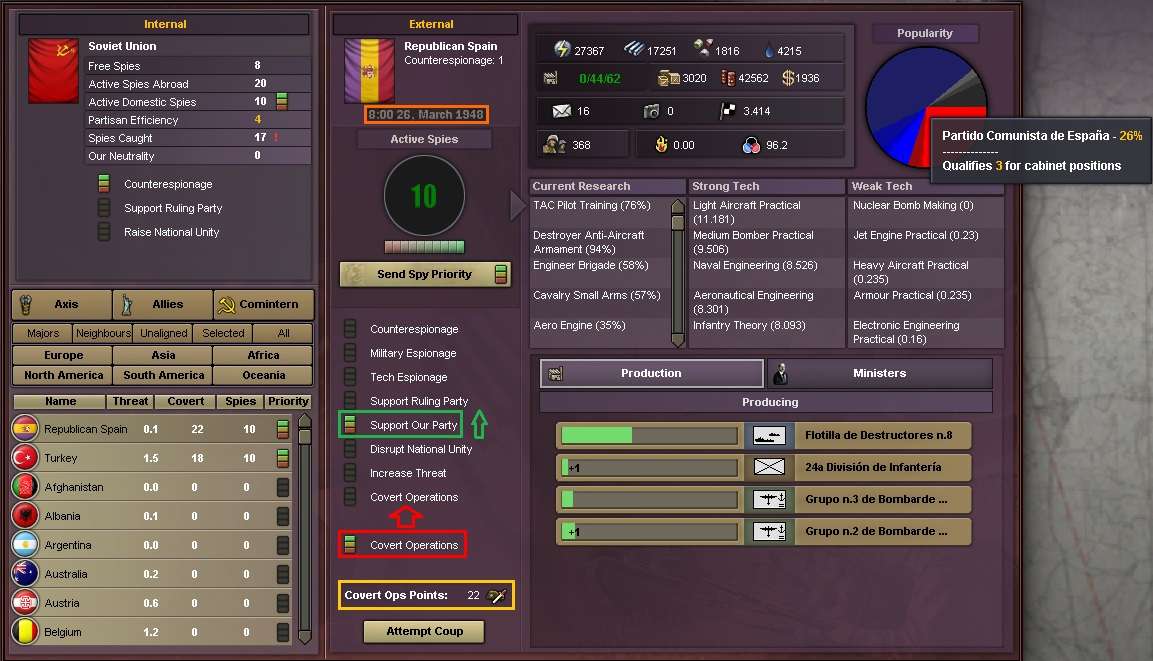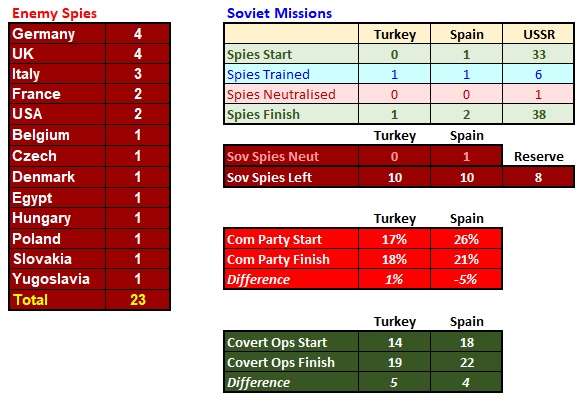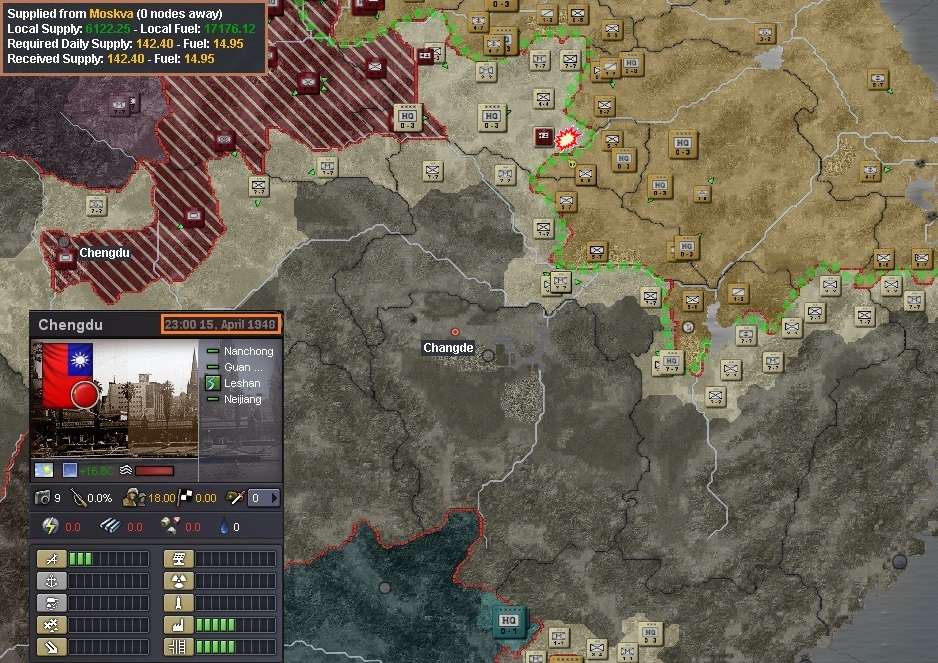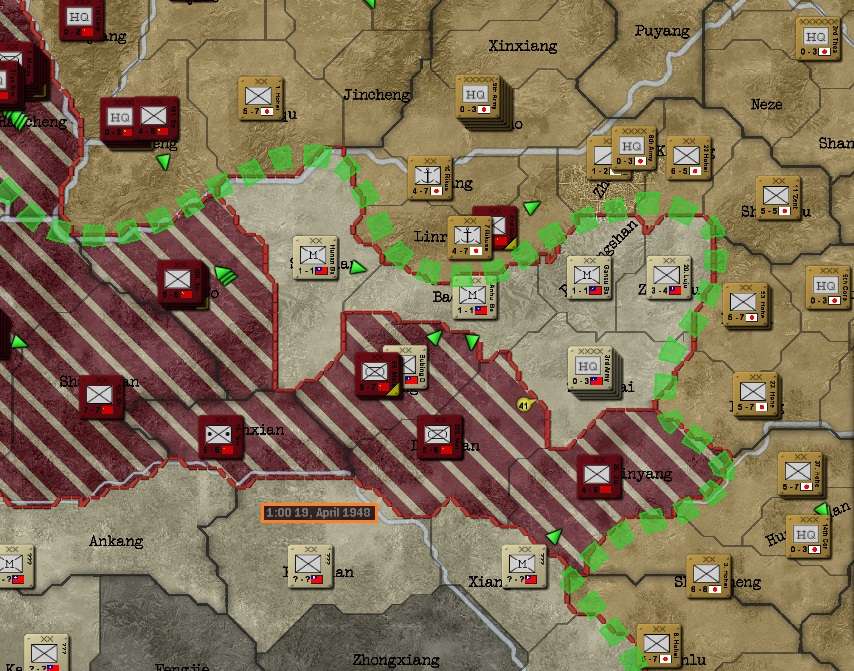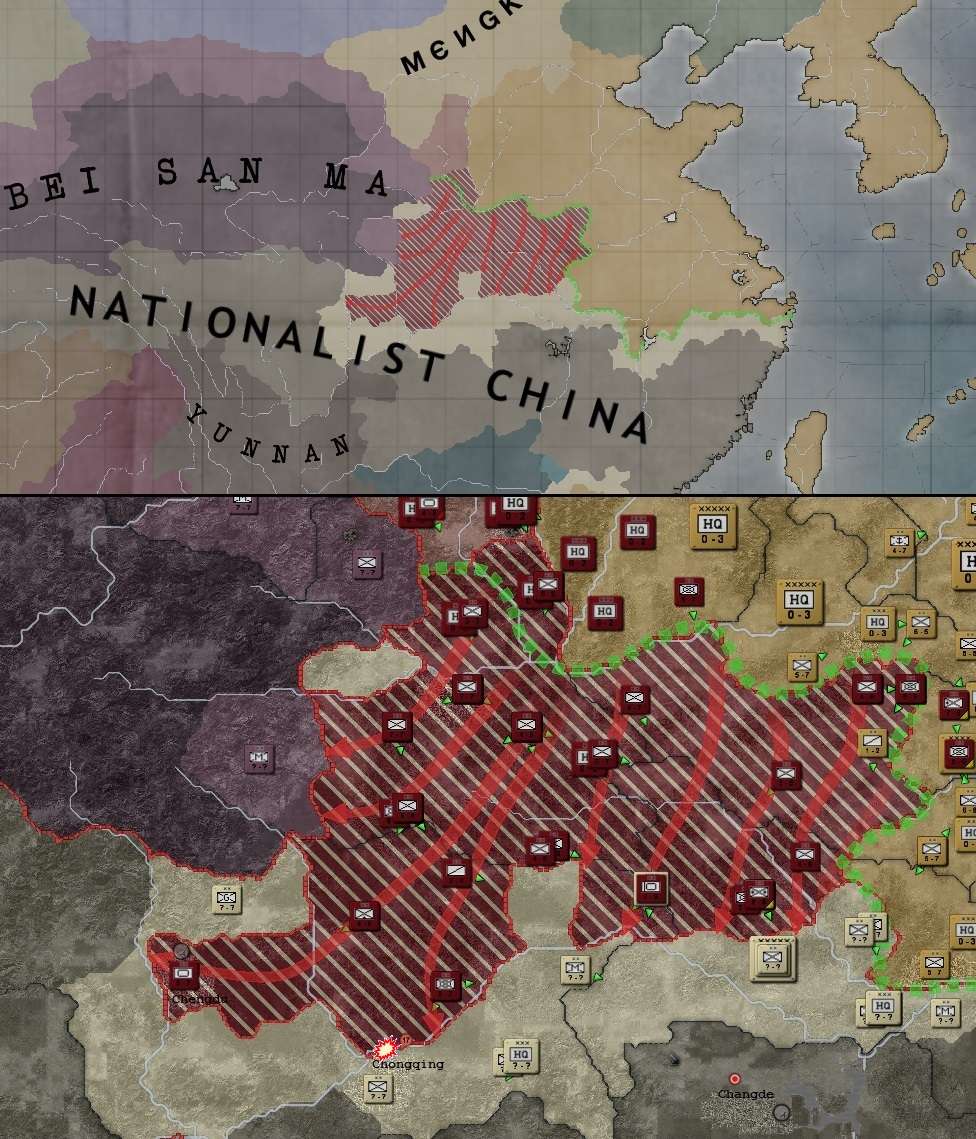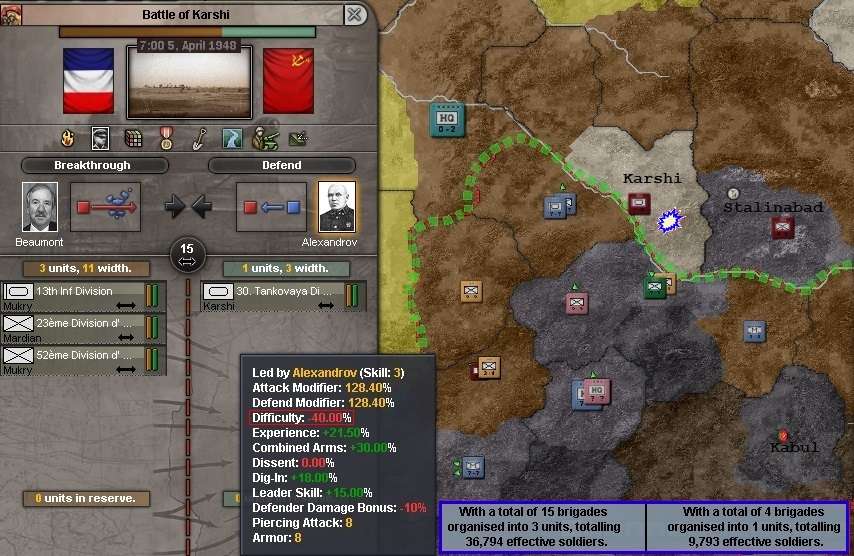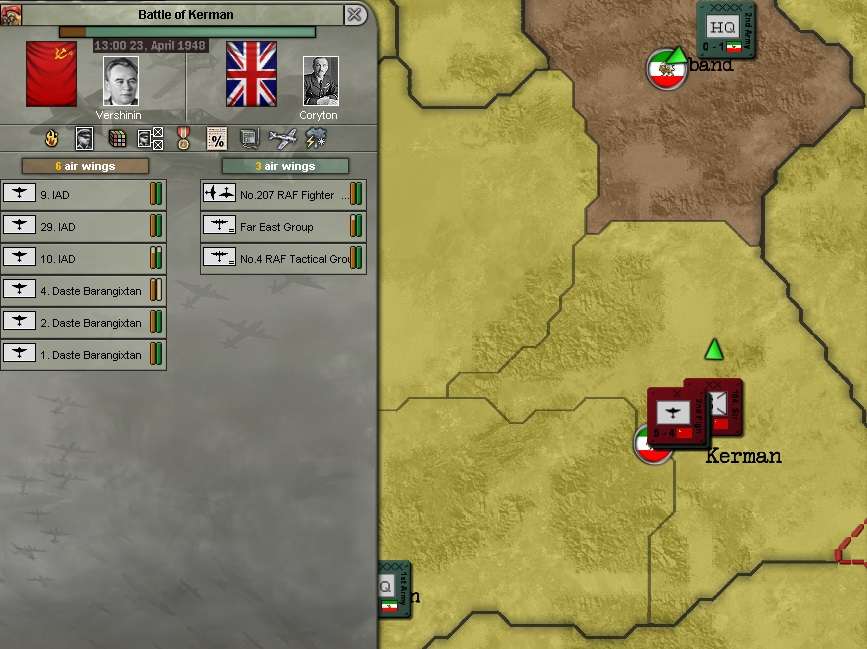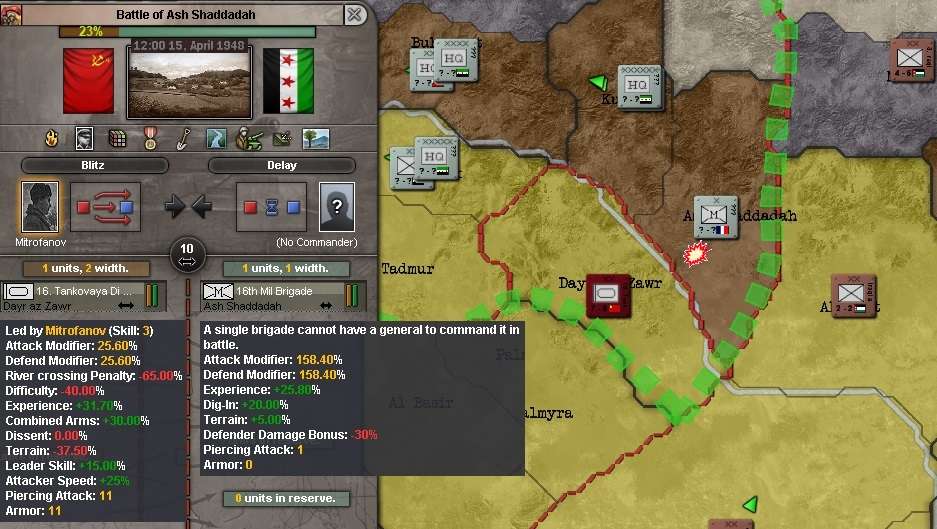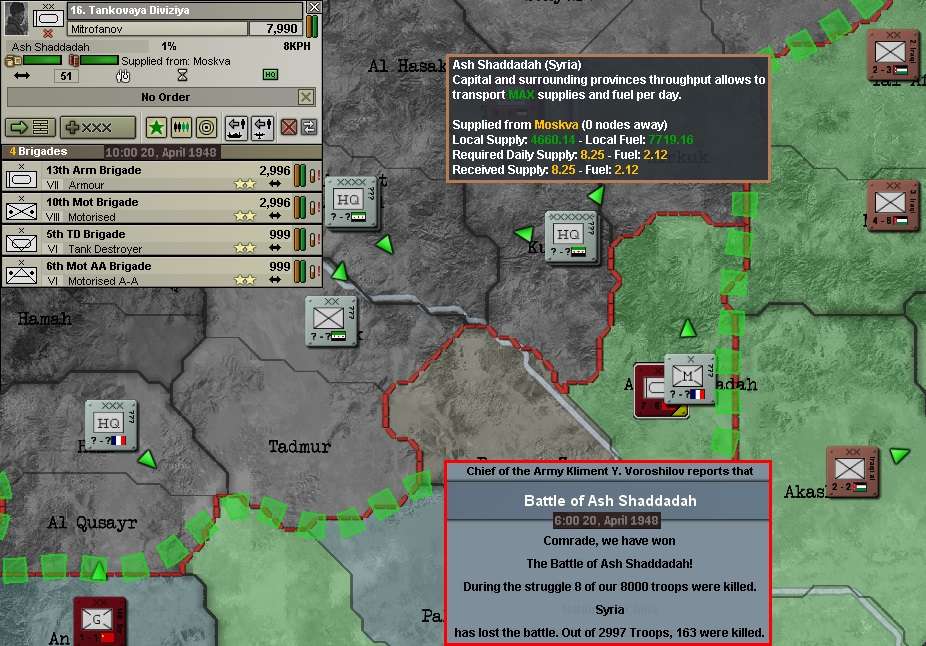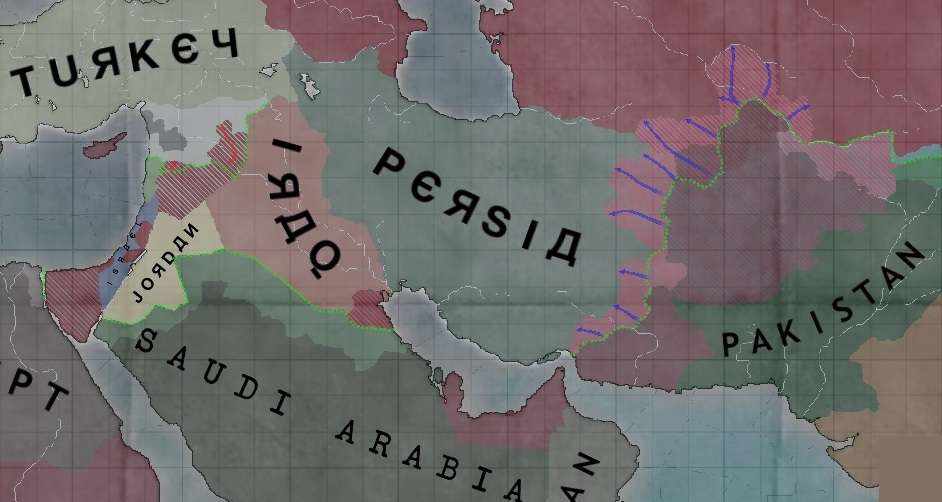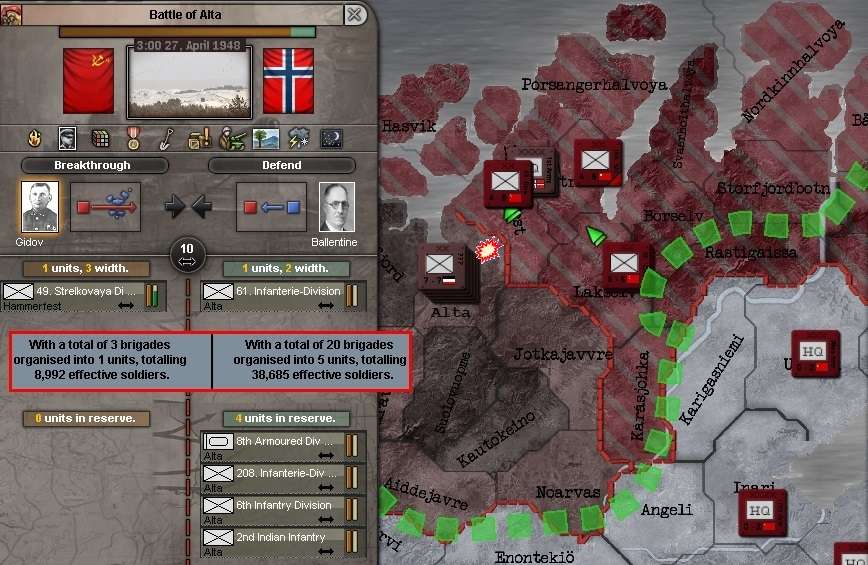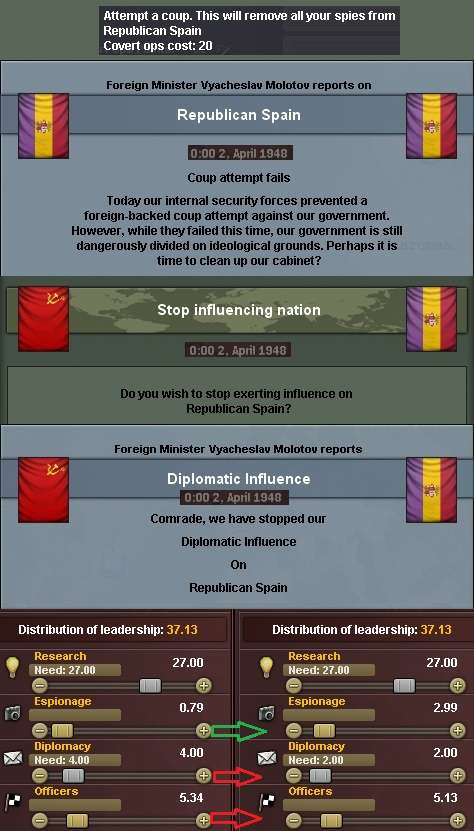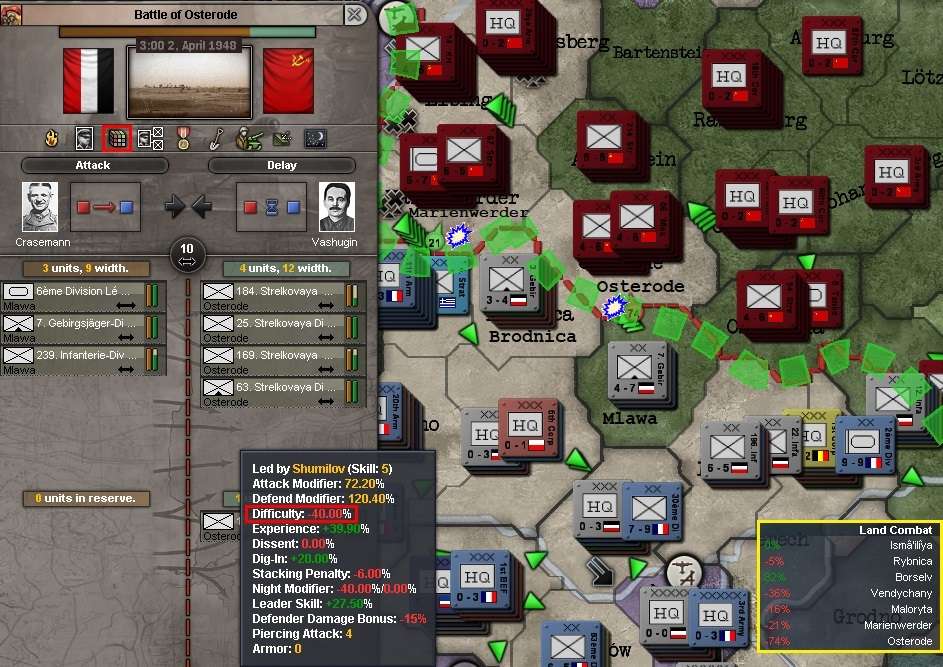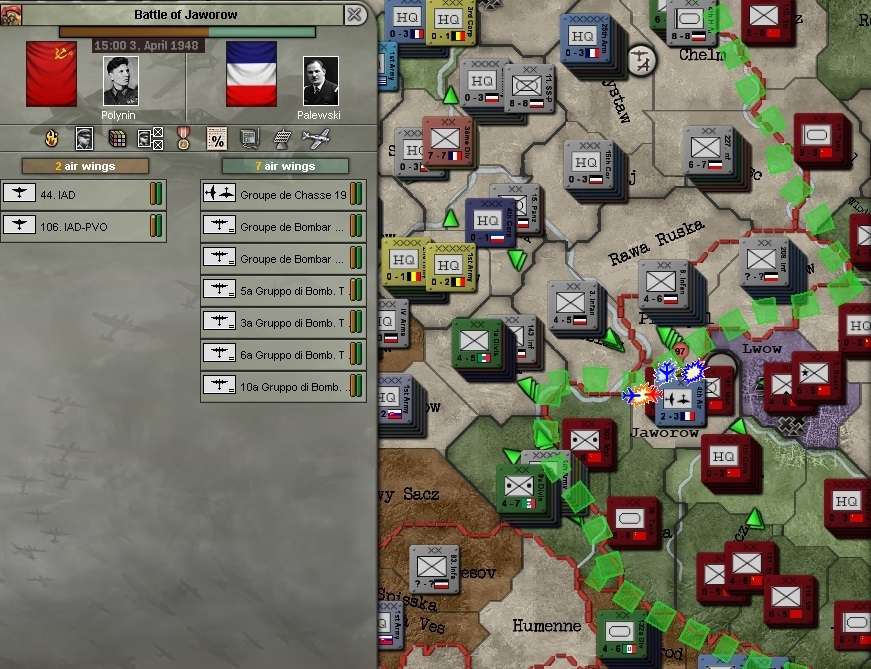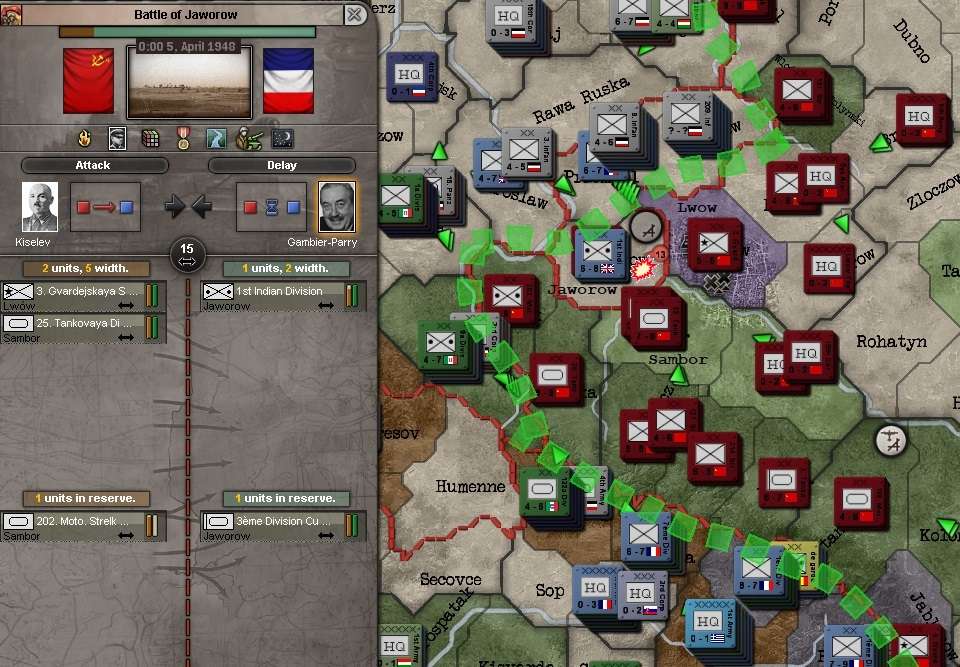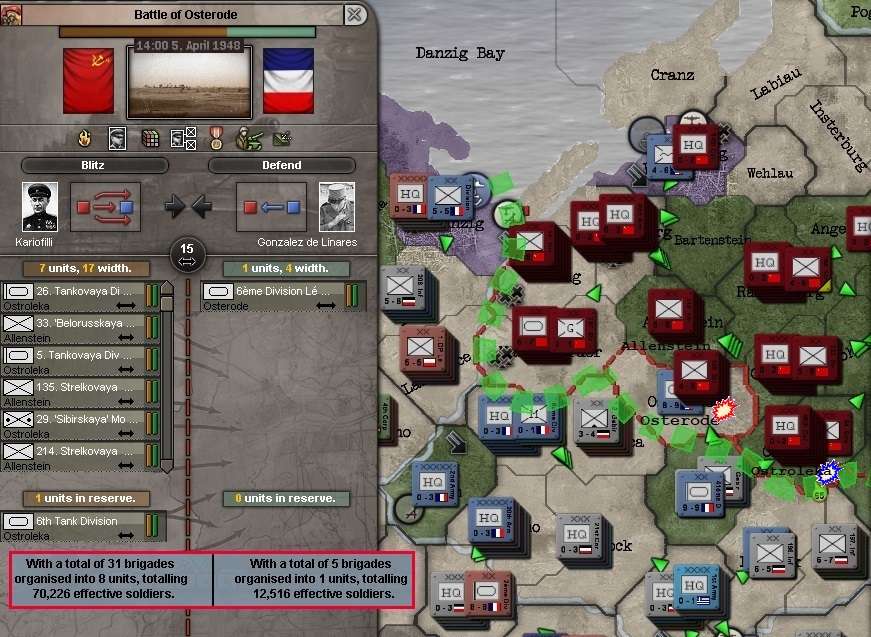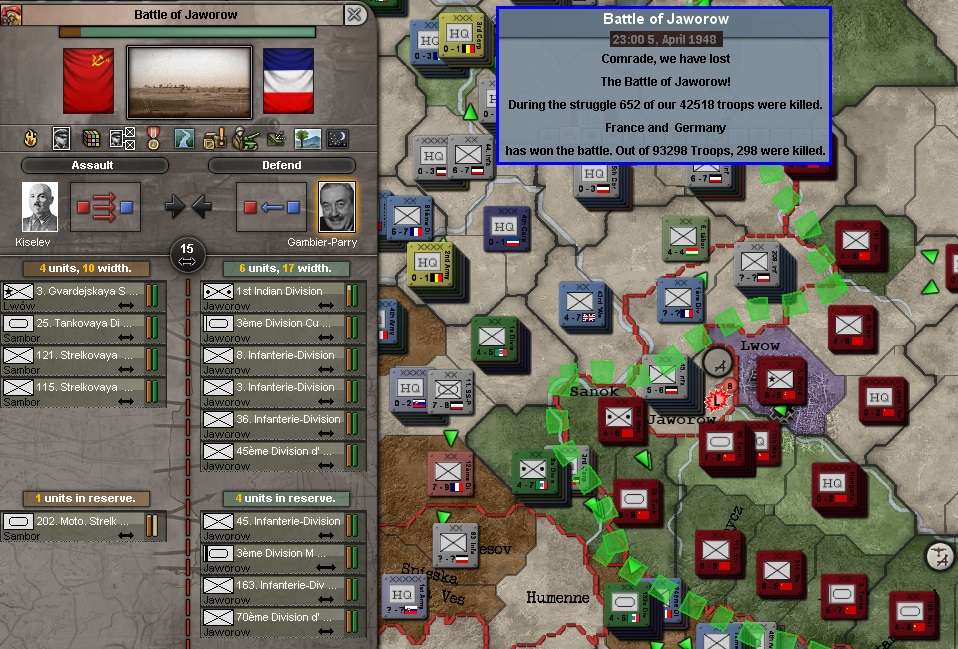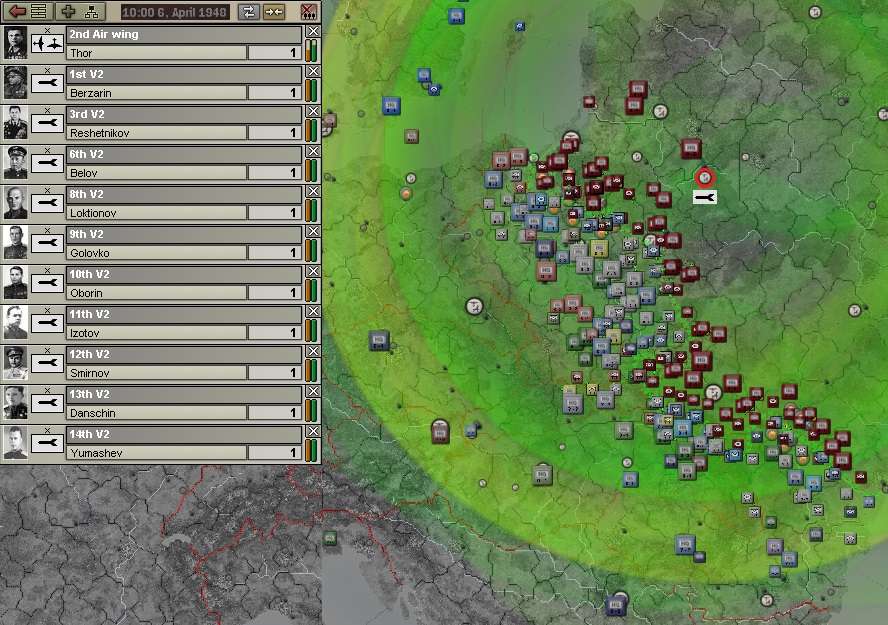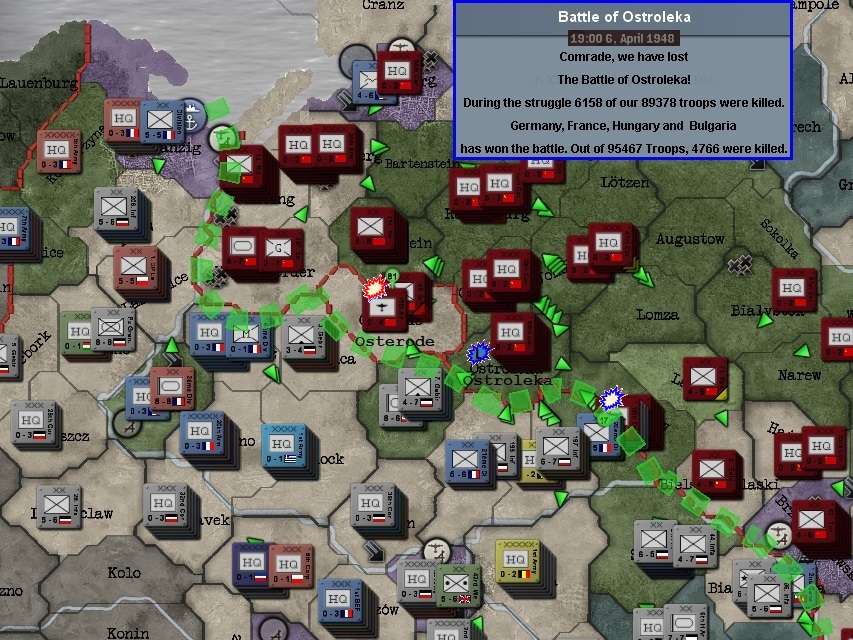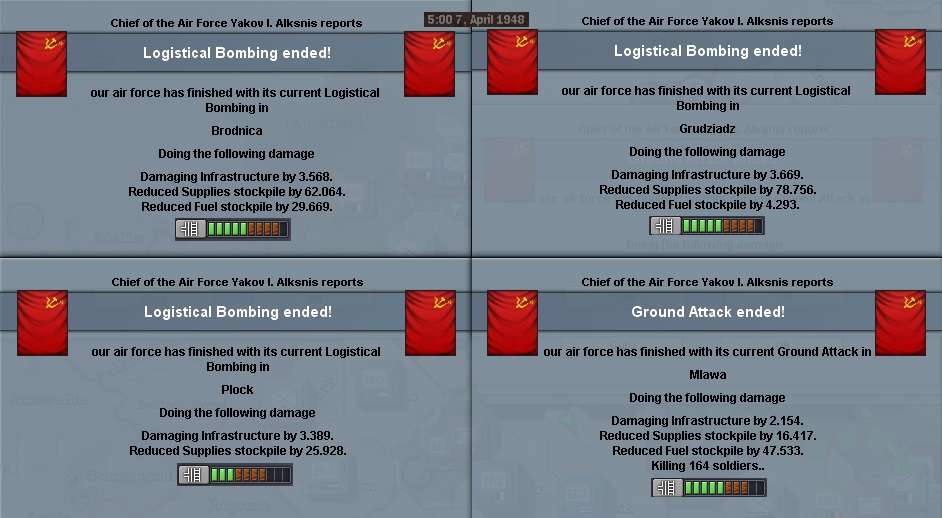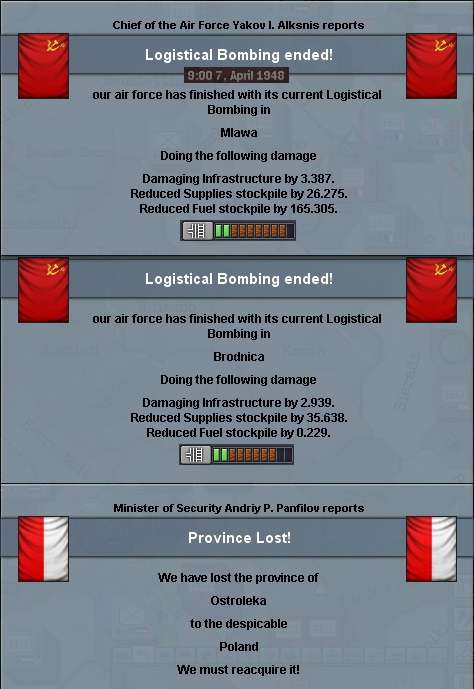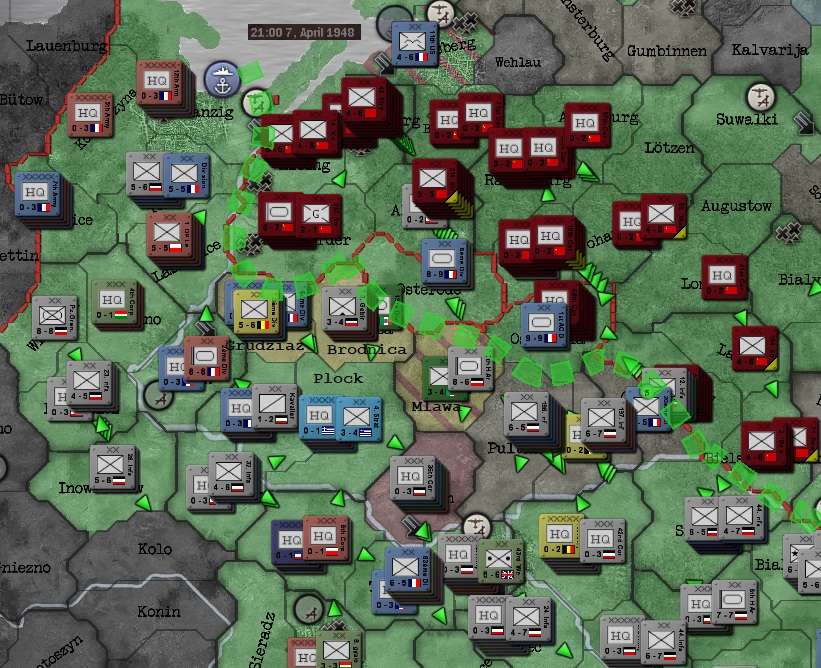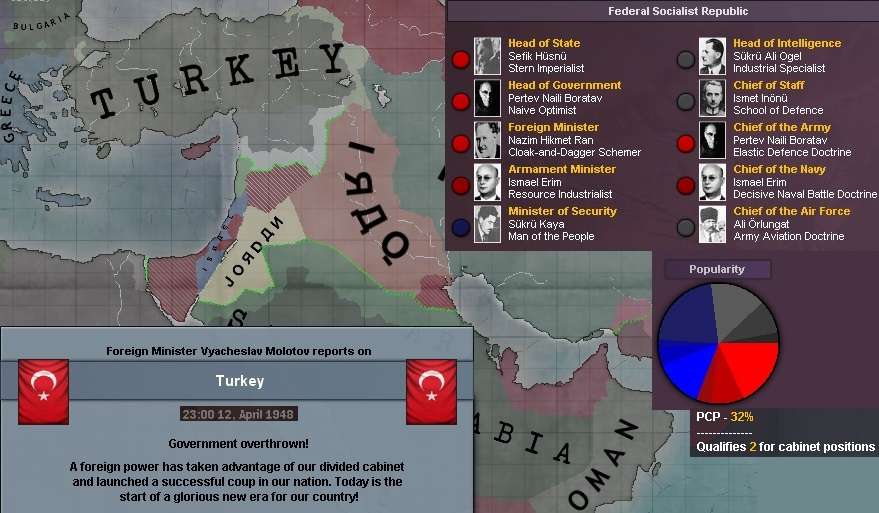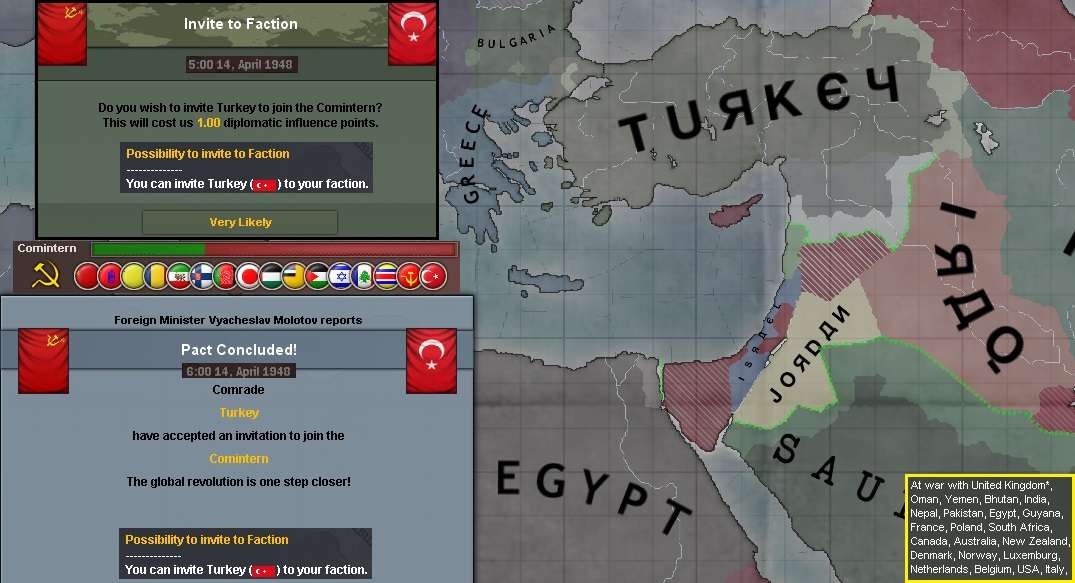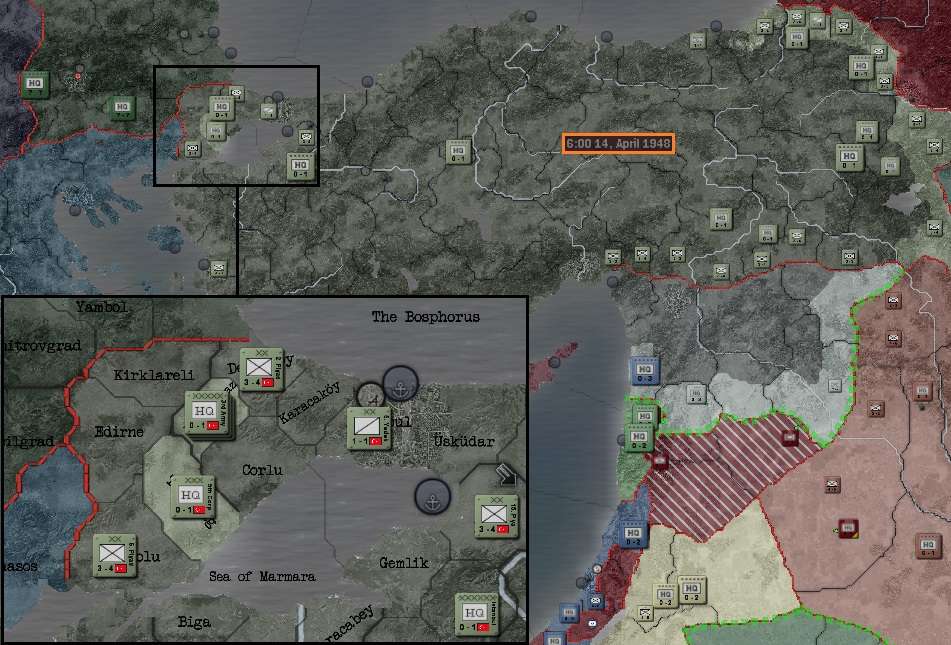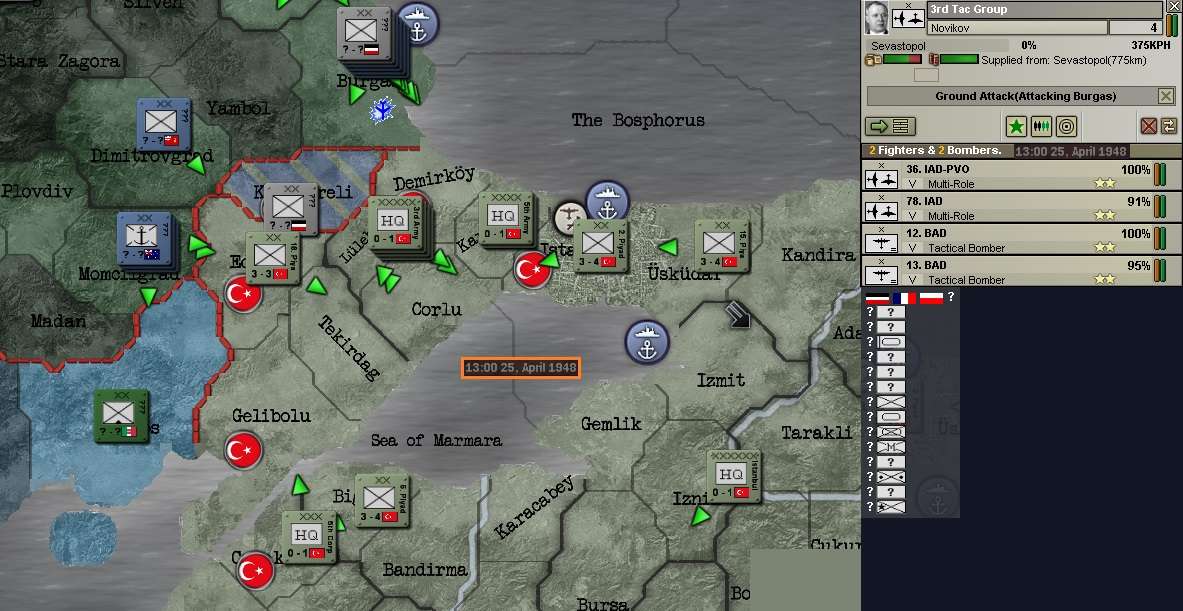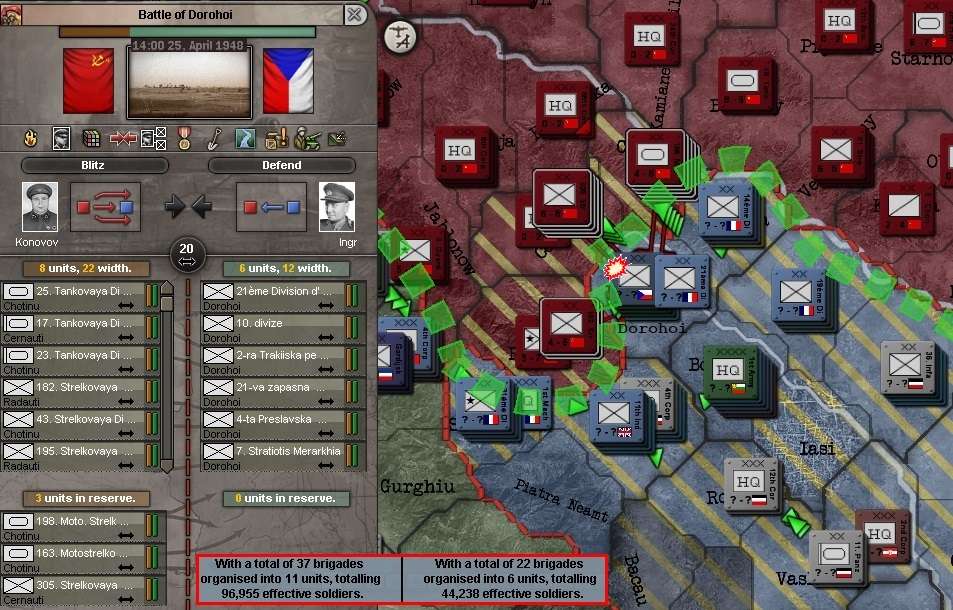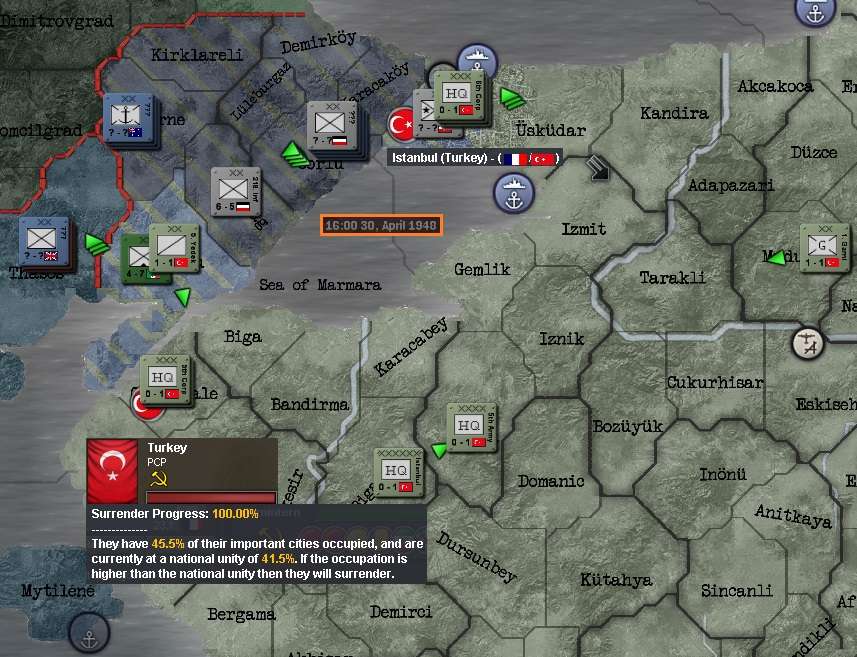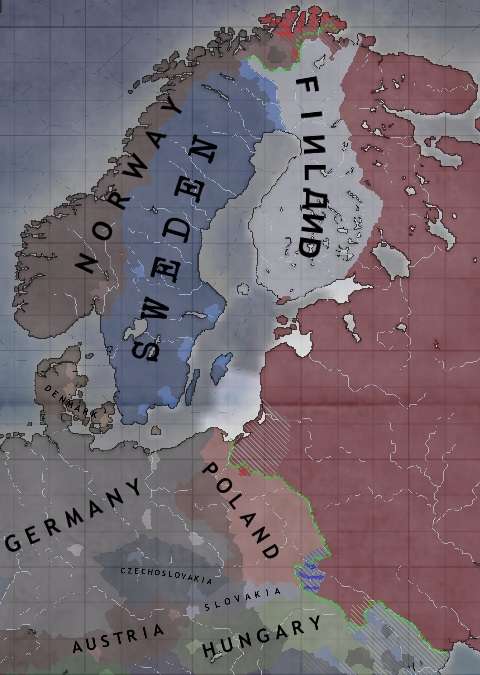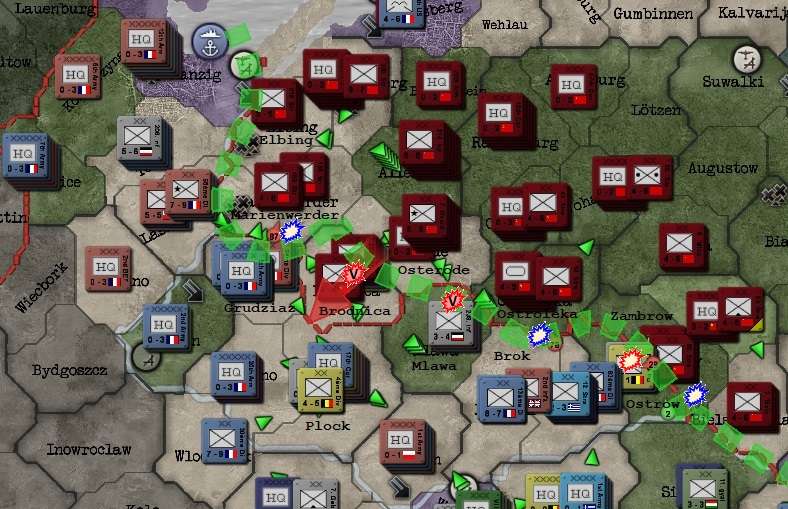Chapter 41: February 1948
Chapter 41: February 1948
Introduction
January 1948 saw the Soviets concentrate on trying to force their way through to Danzig, in the hopes of unravelling the Polish defence and then using nukes to bludgeon them into surrender. Stalin hoped this Polish ‘domino’ would in turn lead to a breakthrough into Germany and the seizure of Berlin. If Germany could be forced to surrender, the whole complexion of the war in Europe might change.
The other key offensive objective in Europe was to wrap up the large but poorly supplied Allied presence in the north of Norway, not only wiping out tens of thousands of enemy troops, but perhaps more importantly freeing up many more divisions for other theatres. Defensively, the Allied offensive in Romania was proving hard to contain, requiring more and more direct STAVKA involvement to stem the tide.
The limits of current possibilities appear to have been reached in the Middle East at the Suez Canal, while Afghanistan was in dire straits. The bright spot continued to be in the Far East, where the campaign against Mengukuo was now progressing well.
******
1. The Far East
The supply situation in the Far East seemed reasonable and it was hoped the westward movement of the main armies across Manchuria would shorten supply lines and improve the overall supply deficit the Soviets had been struggling with through January.
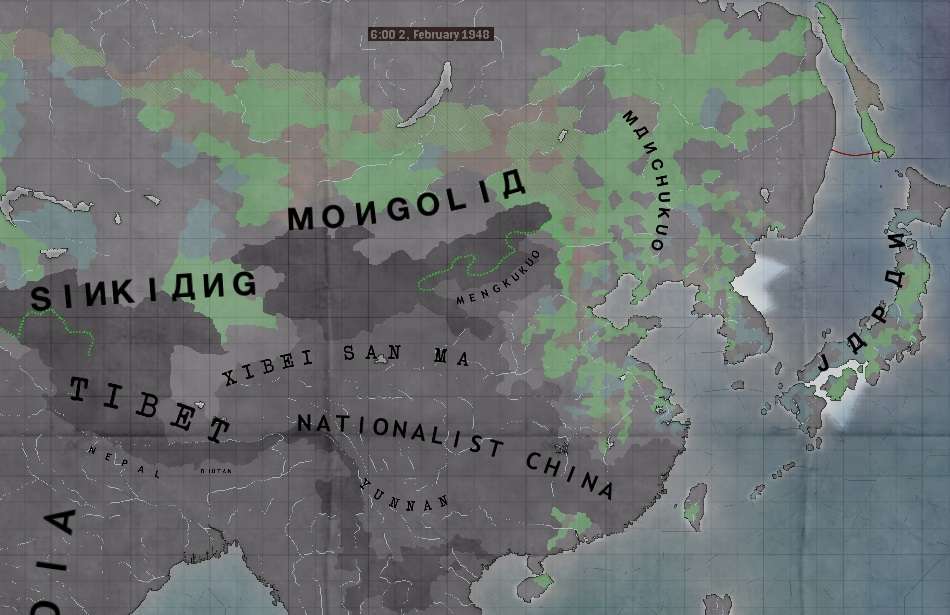
The dotted green line depicts the front at the start of the month.
The Mengukuo capital of Taibus Qi was taken on the morning of 4 February: it was hoped this would disrupt enemy supply as the new capital was established in Hohhot (also the single VP province) to the south-west.
A series of small skirmishes backed by Soviet air power based in Beiping saw a steady advance over the following weeks, with Hohhot attacked at 1600hr on 19 February. Victory came at 2300hr the same day, but it would take until 25 February to occupy it.
In the meantime and the campaign virtually won, a large proportion of the eastern VVS wings was transferred to the west on 22 February, where the need was greatest and the toll was wearing down the endurance of their comrades.
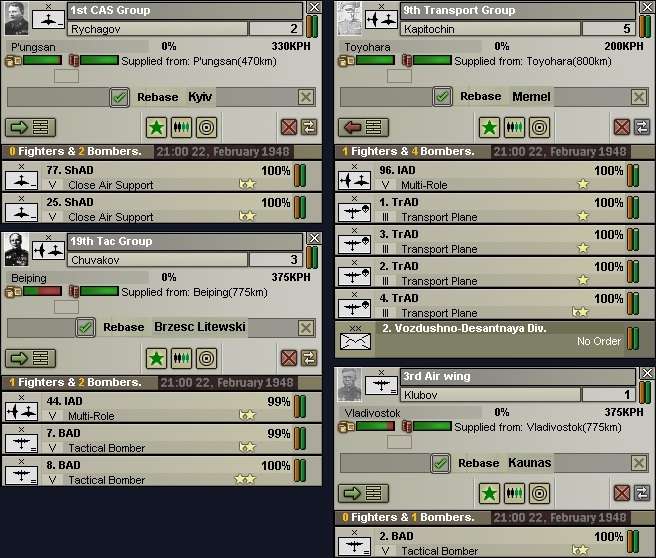
Hohhot fell early on 25 February, but the government of Mengukuo took until the beginning of the next day to formally surrender and be forcibly admitted into the Comintern. They were at truce with the Allies, but some French and NatChi troops remained in the vicinity and would need to be chased out of ‘tidied up’.

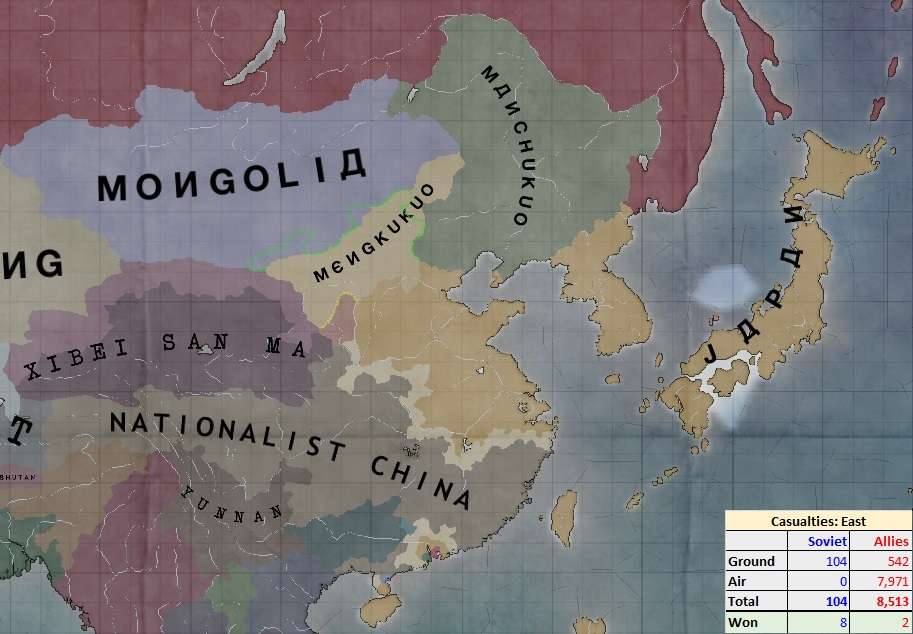
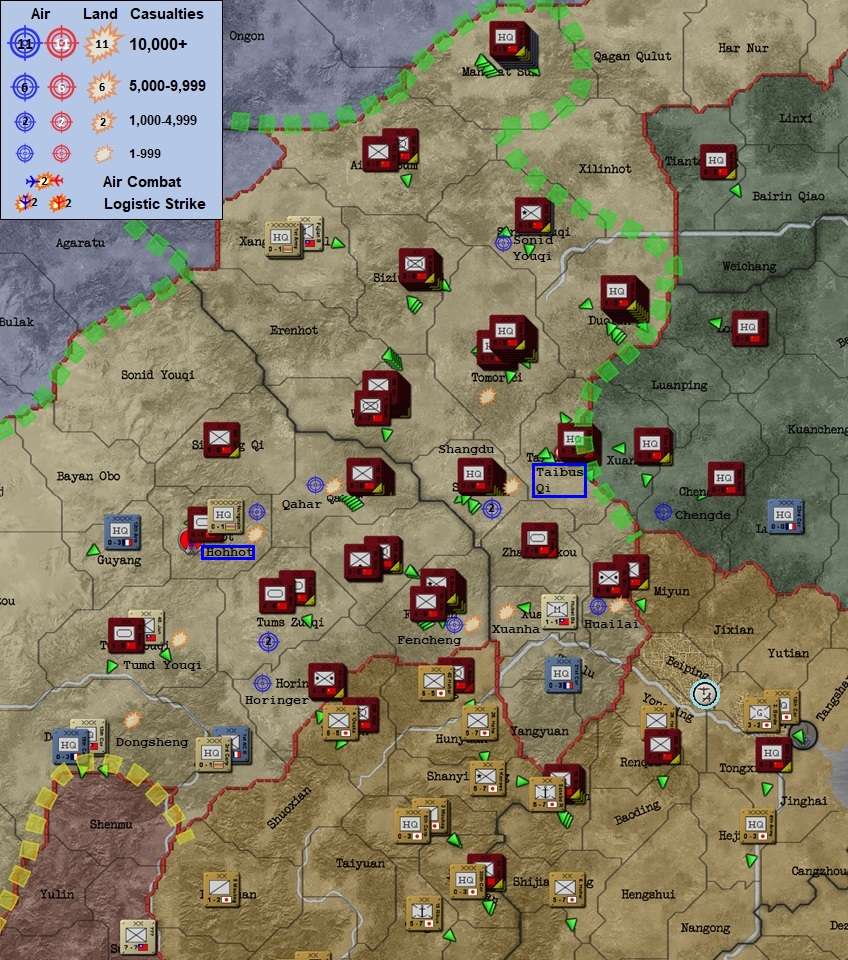
Another tweak to the icon system again, trying to show the total size of battles in each province both graphically and with numbers (in thousands), something similar for air strikes and combat from each side. Let me know if it works any better for campaign summary. No arrows here, because of the Mengukuo capitulation – everything between the green and yellow lines was occupied.
******
2. The Middle East
The continuing British logistic raids on Misfaq were ended on 1 February, when the three newly arrived INT wings in Tel Aviv Yavo engaged two RAF STRAT and 3 x INT early that morning. No great damage was done to either side, but the British STRAT did not return again that month as the infrastructure in Misfaq was slowly repaired.
The overall supply situation in both the Middle East and Central Asia on 2 February is shown below.
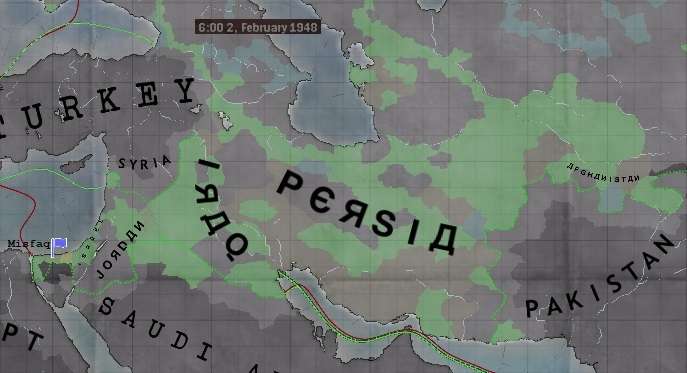
The attack on Ismâ’iliya that had started in January continued until 1 Tank Div reinforced at 1000hr on 4 February. Despite the unsuited formations and difficulty of the cross-canal assault, they had the armour advantage while the Egyptians were at about 66% organisation.
But by 1600hr on the 6th the attack was discontinued as it had virtually no chance of success (Soviets 679/16,982; Egypt 13/10,364 killed). Apart from that battle, the rest of the combat was scattered skirmishes where the Egyptians tried to slip across the Canal, to no avail.
******
3. Central Asia
An early investigation of the main Pakistani RAF air base in Karachi showed it was out of range of the 630km range of an SS-6 (V2) strike from the nearest Persian (Bandar e ‘Abbas, 739km) or Soviet (Stalinabad, 833km). And the range of the three Persian INT wings in Bandar e ‘Abbas was too short to contest RAF raids in eastern Persia or western Afghanistan. Comintern forces would remain at the mercy of RAF strikes for the rest of the month, to considerable Soviet loss.
The results of the battles for Kabul and Herat that occurred over the next few weeks were unrecorded by the Soviets, as only Afghan Army forces were involved. If they did fight back, it was to no avail: Afghanistan surrendered at midnight on 16 February 1948.

By 27 February, Stalinabad’s air base expansion was completed. It was considered worth defending (including for its factories) and a mountain division transferred from the Persian border was on its way to hold it.
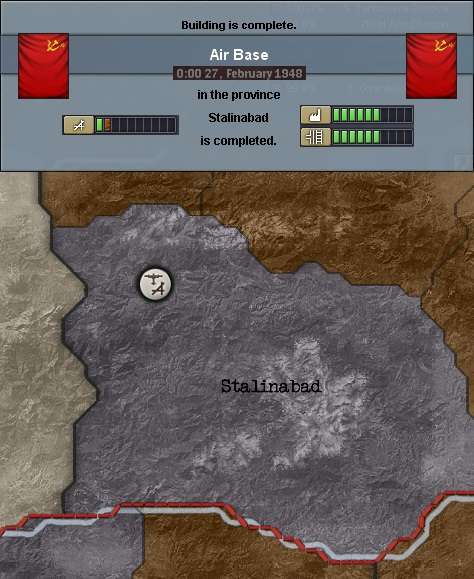
The largest battle in the sector came towards the end of the month, where a heavy tank division arrived in the desert province of Khash (eastern Persia) in time to repel an attack (Soviets 143/11,000; Pakistan 1,021/8,995 killed). It was one of the first Allied reverses in the sector for weeks, though the defenders also took over 2,600 casualties from RAF air strikes from 26-28 February.
Also of note was an Allied attack on Iranshahr that started on the morning of 28 February – led by two Thai divisions! It showed how far Allied support was now coming from and why the situation had been steadily deteriorating.
By the end of the month, the Allied push had extended into the fringes of eastern Persia, as well as up to the Soviet-Afghan border. The RAF’s toll on the Soviets had been heavy.
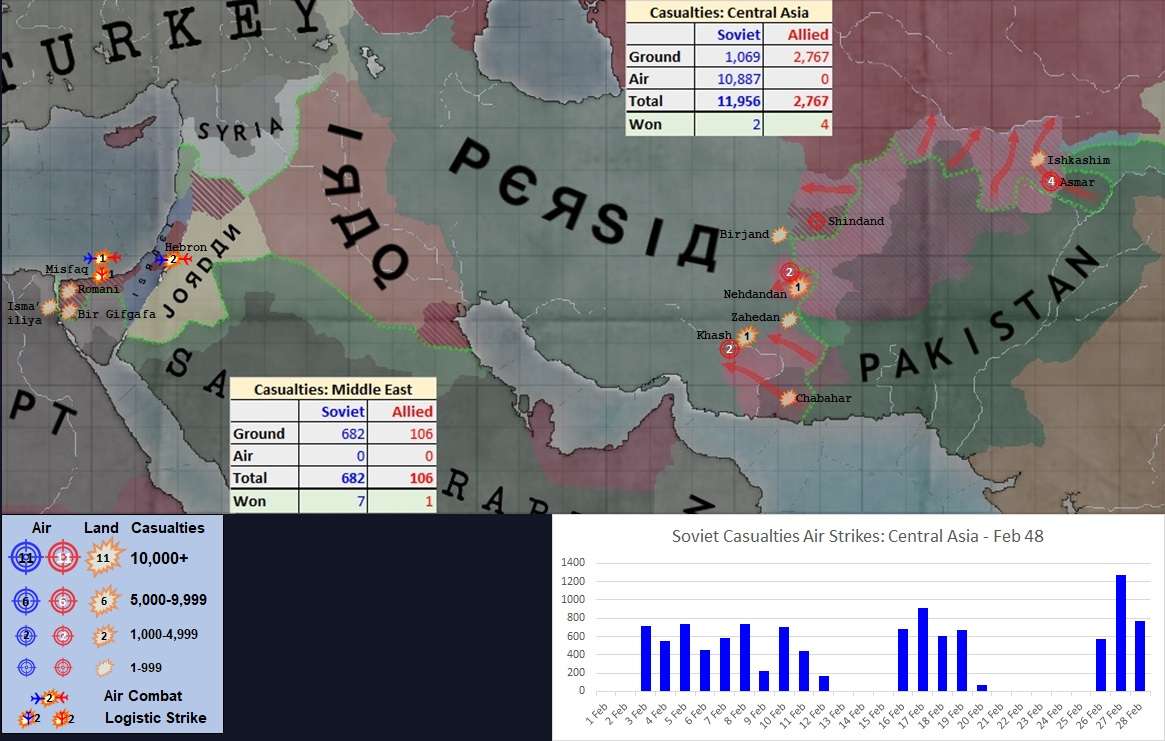
******
4. The North
Logistic raids focused on Kirkenes from 7-9 February in support of the continuing huge but slow battles for Polmak and Kirkenes that had begun in late January. They were suspended when there was nothing left to destroy by 1100hr on the 9th.
Despite the high hopes for it, the attack on Polmak was abandoned (spontaneously) by the troops conducting it on 16 February. The hope that the incessant combat and lack of supplies would shatter Allied organisation, allowing Kirkenes to then be surrounded, were dashed for now.
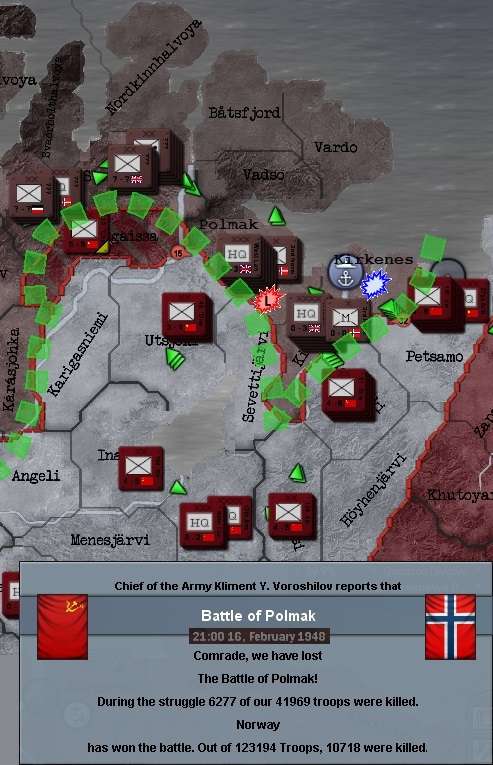
A day later, the attack on Kirkenes was called off by STAVKA (Soviets 6,919/97,962; Allies 4,882/90,780 killed). Troops were rested and repositioned for a later attempt, but for now Stalin’s hopes for a victory dividend of spare troops was frustrated.
Logistic bombing of Kirkenes restarted on 24 February, to ensure supplies were kept at a minimum, and would continue through to the 28th. Softening up ground attacks were also recommenced on Kirkenes on the 26th, then transferred to Polmak on 27-28 February when a local (AI) commander initiated a new attack there at 1900hr on the 26th. It was just a single division, but he had seen Allied organisation had deteriorated further and thought it worth another try. Further ground support was also ordered in (by STAVKA) to join the attack.
By the end of the month, the attack was making quite good progress, with a second division joining and waiting to reinforce. At this stage, a renewed attack on Kirkenes would probably only be launched once Polmak had been taken, cutting them off.
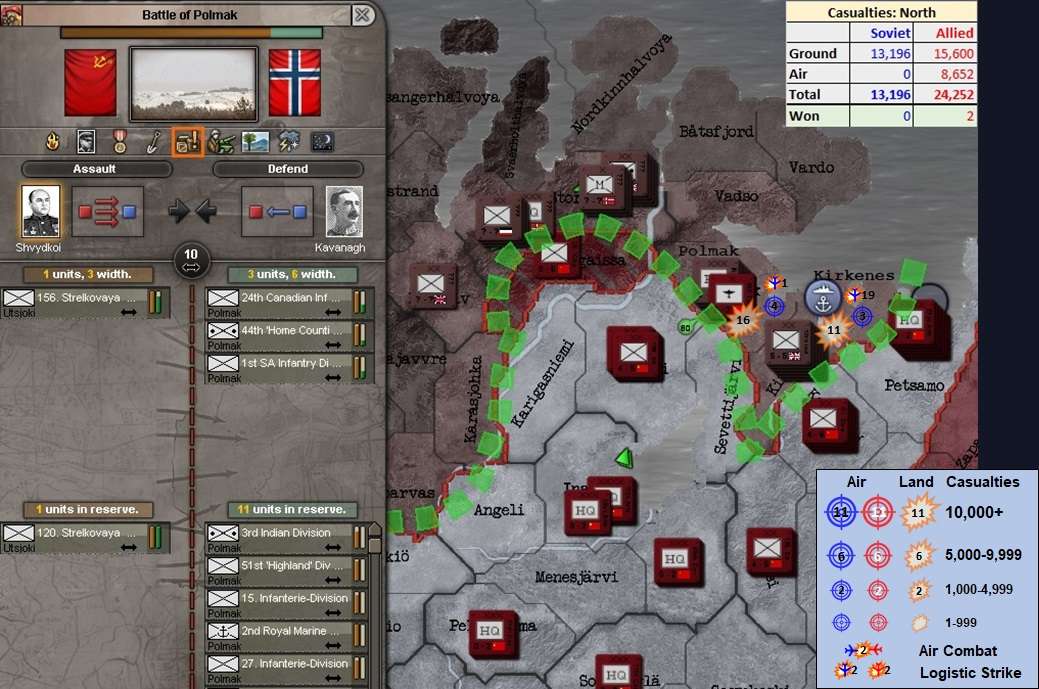
******
5. The West
At midnight on 1 February, three new SS-6 batteries were deployed in air bases along the front: they would take a while to work up organisation and be ready for use, but others were still in position.
A ‘special’ [non-intel based from quick info-tags, but which I considered interesting for the readership and fair game in general terms, not top secrets] report on German and French military industry on 2 February showed Germany continued to have severe problems producing enough fuel and supplies, while crude oil and rare materials stockpiles were empty. They did have plenty of manpower, however: attrition would not be exhausting that in a hurry. The main industrial effect of this was to limit their economy and only implement a tiny proportion of their possible upgrades, which would flow through into operational effectiveness not reaching the full potential their technology would have allowed. Unsurprisingly, they were getting considerable lend-lease support from the US.
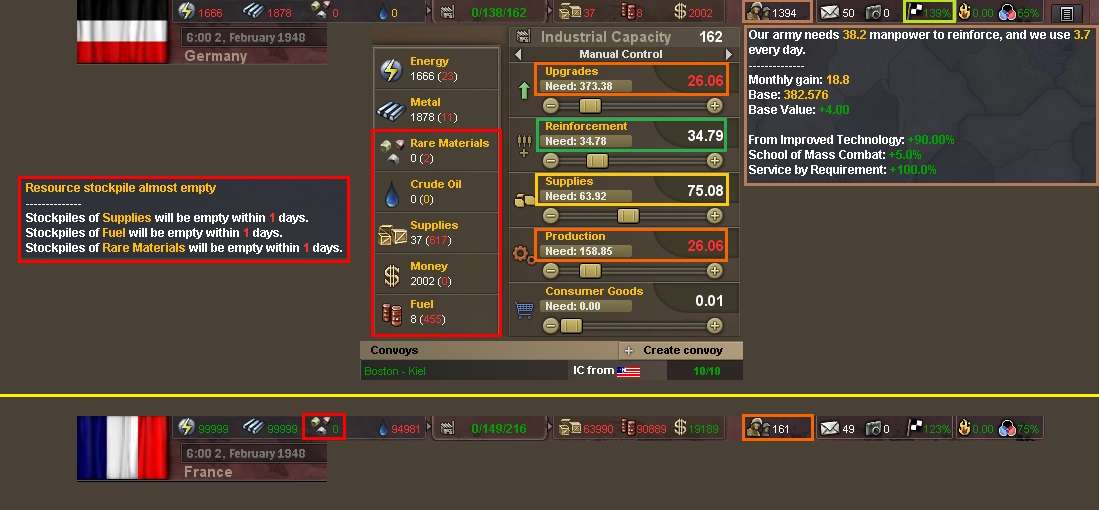
The Soviet supply network on 2 February is shown below: it seemed to be holding up well enough for now.
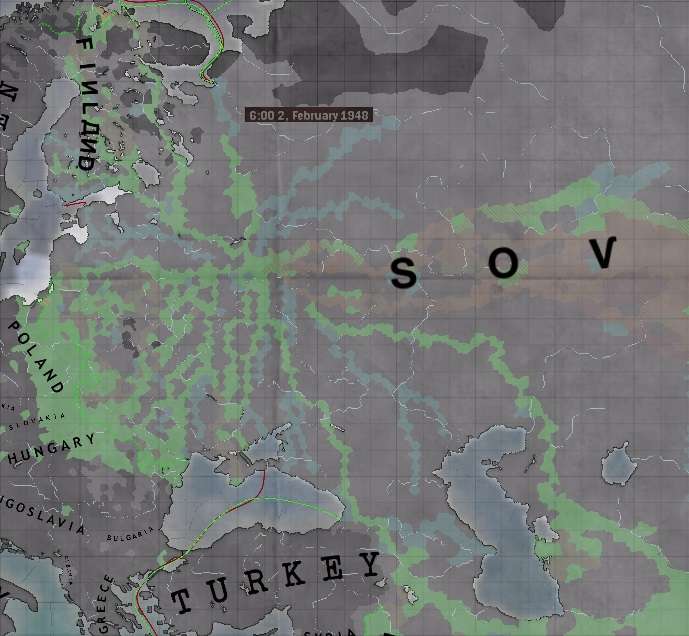
In general terms, by the end of the month, the constant activity had begun to wear down the VVS somewhat, though this time careful management ensured no more fighter wings were destroyed, though there were a few close calls (down to 6 or 9% strength a couple of times at the end of big dogfights). The repair and rotate system was kept working hard and by the end of the month the wings transferred from the Far East on 21 February were starting to regain an operational level of organisation. [More air stats and graphs at the end of the section.]
******
5a. Prussia-Poland Sector
An SS-6 runway strike on Breslau on 3 February was launched when 16 German and French wings (11 x INT, 1 x M/R, 4 x TAC) were found using its rebuilt 7.33 wing capacity repair facilities, with 6.1 of that knocked out.
The [AI led] push through to Danzig was making good progress, with Braunsberg finally occupied at 0700hr on 4 February and an attack on Elbing launched immediately. Elbing sat on the east bank of the Vistula, with Danzig on the other side. The two defending German (-27%) and Italian (-40.3%) divisions were both short of supplies and progress looked promising. Three hours later, Marienwerder (to the immediate south of Elbing, also on the Vistula) was occupied.
The battle for Elbing was won and it was occupied by advance Soviet units at 0100hr on 6 February. The operation to cross the Vistula and take Danzig now began as the [AI] army commanders mustered forces and STAVKA ensured heavy air support was available. And the Allies also did their best to hit the mustering Soviet forces in Elbing.
The initial attack over the Vistula on Tczew (immediately south of Danzig and the best place to attack it from) met little resistance, with victory won by 1500hr on 9 February after a short fight against a weakened French division.
But as often happened, the Allies were able to reinforce Tczew before the Soviets could get across. At 1800hr on 11 February, the Soviet attempts (each by a single division) to force the Vistula on a three province front at Danzig (Soviets 33, Allies 6 killed), Tczew (Soviets 45, Allies 18 killed) and Laskowice (Soviets 257, Allies 10 killed) were all defeated at the same time [AI break-offs] due to unfavourable odds. Stalin was not amused.
Impatient at the field commanders’ lack of ‘vision’, STAVKA intervened on 12 February to initiate a massive attack on Danzig across the Vistula, hoping to blast the Allies out before they could establish themselves. But it was too late: an exhausted German garrison division would have proved easy enough pickings, but a fresh British Royal Marine division was now defending the city with its heavy fixed fortifications and the breakthrough attempt was quickly defeated.
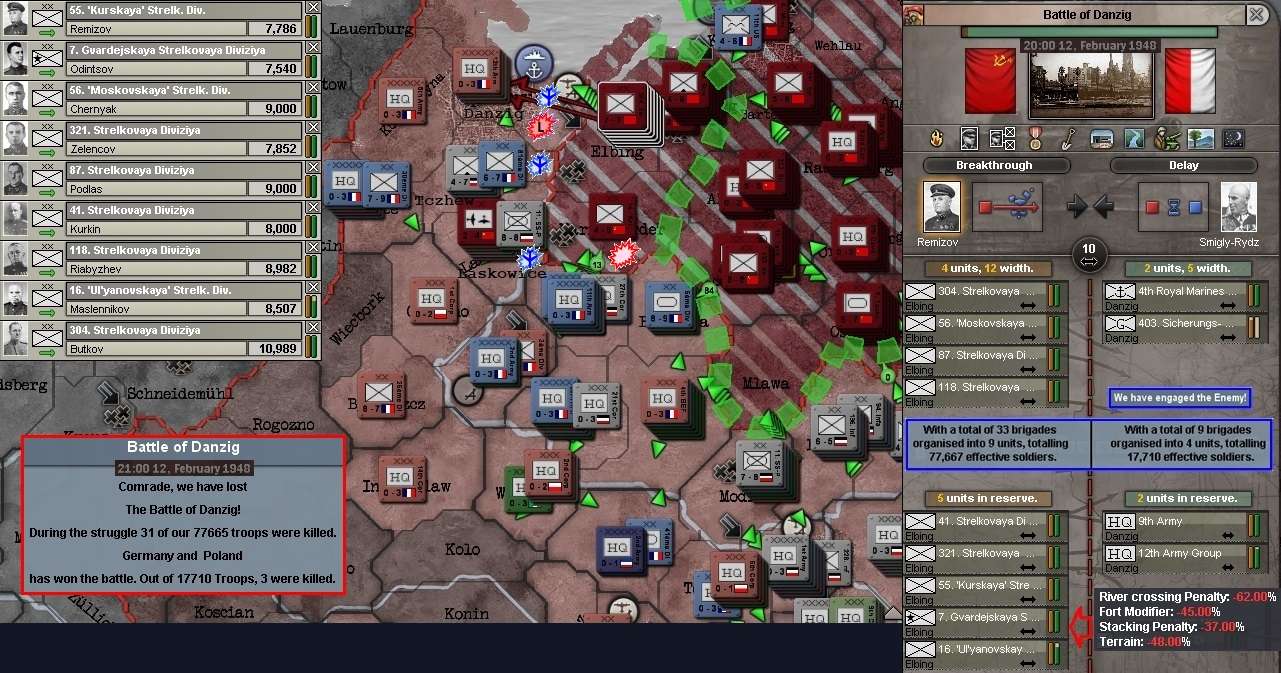
Logistic strikes began on Danzig on 13 February to try to destroy infrastructure, supplies and fuel dumps with the four STRAT wings based in Finland, with VVS INT cover provided from Suwalki and Minsk. But the Luftwaffe contested the raids throughout 14 February and the bombers were soon running very low on organisation, which had not been high to start with and had to be suspended after moderate damage had been done. The SS-6s were held back for now, as they were not held in great numbers and were being reserved primarily for airfield interdiction.
Another attack was tried on Laskowice on 16 February, but it was now heavily defended and it too failed (Soviets 346/25,708; Allies 35/54,467 killed). The same day, the Germans managed to force the withdrawal for repair of one of the VVS TAC group (1 x M/R, 2 x TAC) that had been pummelling Tczew, leaving a fresher mixed group (M/R, TAC, CAS) on the task.
By mid-month, the front remained fairly static from the Baltic to Brzesc Litewski, but the Allies were steadily driving a salient in towards Lwow, which was now under threat. Their defences along the northern Vistula had now hardened up, their supply situation seemed to be better and there now seemed little immediate prospect of taking Danzig any time soon. And the Allies were advancing on a broad front in eastern Romania, threatening the Soviet border.
At that point, with the push in Norway and the Middle East stalled and Afghanistan collapsing, Stalin lost patience. “No more mister nice guy” was his attitude. “The Poles refuse to be liberated – well, we will teach them a harsh lesson”.
A specially assembled task force formed under the guise of 12 CAS Group, with four wings of Yak-16s flying air superiority, took off for Warsaw from Kaunas at 0100hr on 17 February with a shocking payload. The two Luftwaffe fighter wings sent up to intercept hit the INT rather than the bomber group and made little impression. At 0400hr, Warsaw disappeared under a huge mushroom cloud.
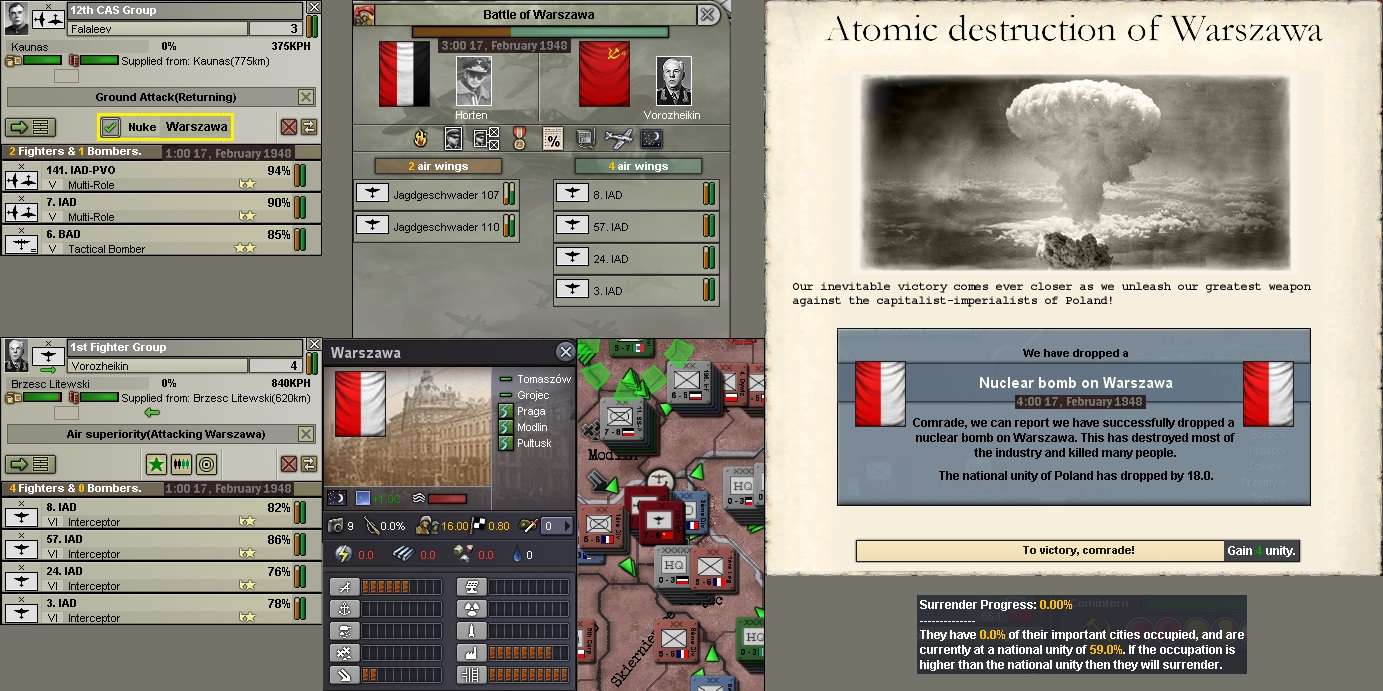
By 1500hr that evening, the latest attack on Tczew (including two Guards and four infantry divisions), still with reasonable air support, seemed to be making some progress [though only 27%] against three partly disorganised German and French divisions.
Alas, the heavy concentration of Soviet troops east of the Vistula seemed to be creating some supply problems for the attackers, who had enjoyed quite good service over the whole front to that point. The attackers in Elbing remained in supply, but some units to their east were beginning to run out and Marienwerder was looking under-supplied.
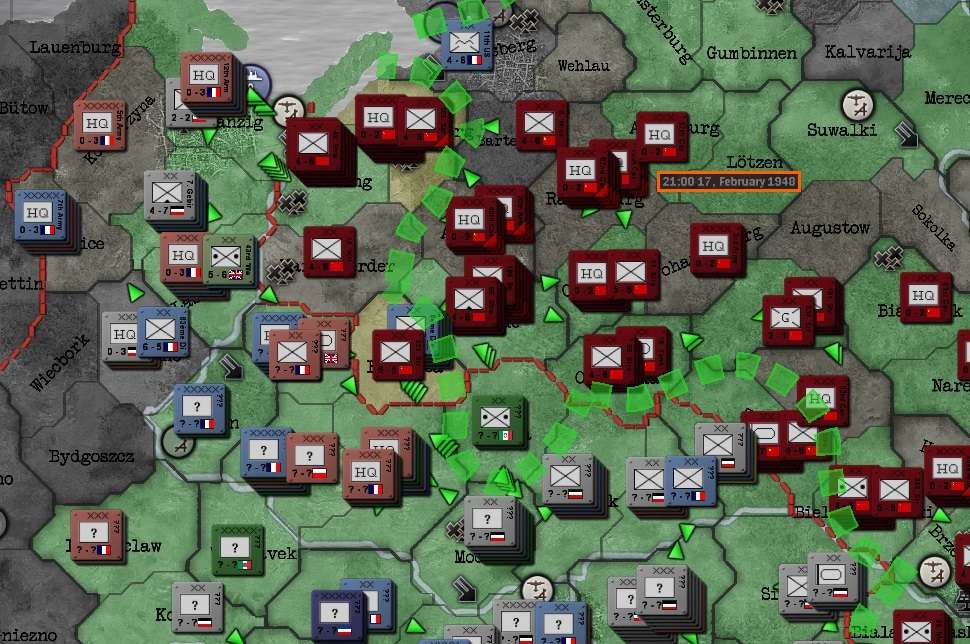
Note: 11 Abn Div remains ‘ghosting’ in Königsberg: it’s doing nothing for now and I can do nothing to it.
The situation on the Vistula was deteriorating by the morning of 18 February. Marienwerder was lost with heavy casualties and the attack on Tczew was now withering under an effective spoiling attack from Danzig, including the well-suited British 4th Marine Division. And Brodnica, seized by the Soviets earlier in an attempt to widen the salient towards the Vistula, was also coming under heavy Allied pressure. The Allies had earlier retaken Mlawa, though a Soviet counter-attack was gaining ground there, at least.
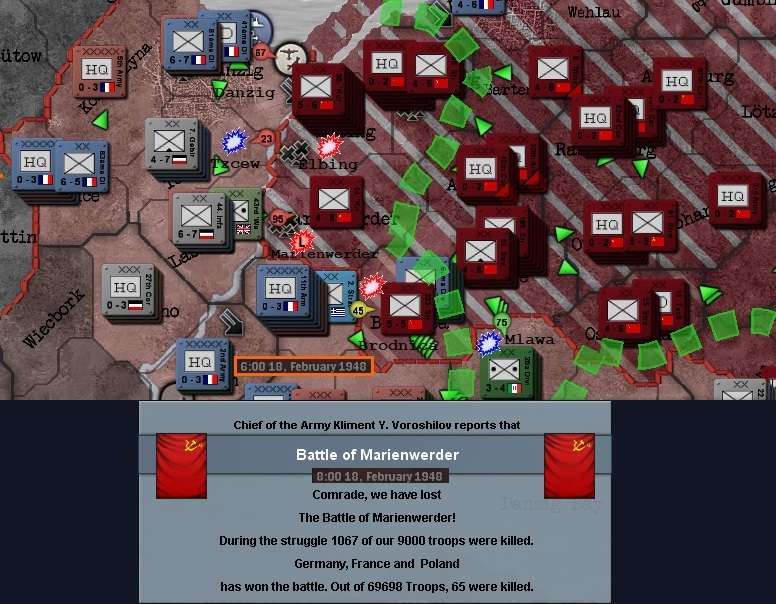

Back up north, the Allies retook Marienwerder at 0700 that morning. At 1600hr the following day, a large [AI directed] counter-attack on Marienwerder with nine divisions in Osterode hit three Allied (two British and one German) divisions. At odds of three-one, STAVKA was hopeful. But the local commander called it off just an hour later (Soviets 99/79,535; Allies 52/24,079 killed)! Stalin was almost apoplectic when he heard this. The Commissars were sent to find scapegoats.
But Stalin had something more severe in mind by way of retribution – and not against his own men. Having discovered (via a previous experiment) that 3-4 German INT wings could shoot down an SS-6 flying at 5,000kph [gnashes teeth at the HOI3 designers, but it is what it is in-game], three INT wings were sent to conduct air superiority over Berlin at 1700hr on 20 February. When the designated SS-6 missile arrived [and then hung suspended in the air for three hours while the Germans shot at it, as per usual], the VVS fighters were able to clear its way through. Atomic destruction had been visited on the German capital, in a blow designed to not just dent national morale, but exacerbate their already difficult industrial and supply situation. As well as making a complete mess of their large air base.

I rationalise this as the battery only needing to send one of its however-many missiles to do the job. Rather than the Soviets having developed a remotely piloted hypersonic rocket drone in 1948! But this sequence is as clear a demonstration as you would need to show a not very well worked through mechanic. And that's being kind about it.
The next morning, the Germans responded with a heavy air raid on Elbing, which killed 1,180 of the massed Comintern troops in a single strike before the VVS could subsequently disperse them. The attack on Tczew was re-assessed and deemed too wasteful of troops even by callous Soviet standards (the single largest Soviet loss in one battle so far in the war) and with little chance of success. Even as the Allies were striking north at Bartenstein from Marienwerder, which threatened to cut Elbing off, though another Soviet spoiling attack on Marienwerder itself was showing promise. Brodnica was holding and Mlawa being attacked again.
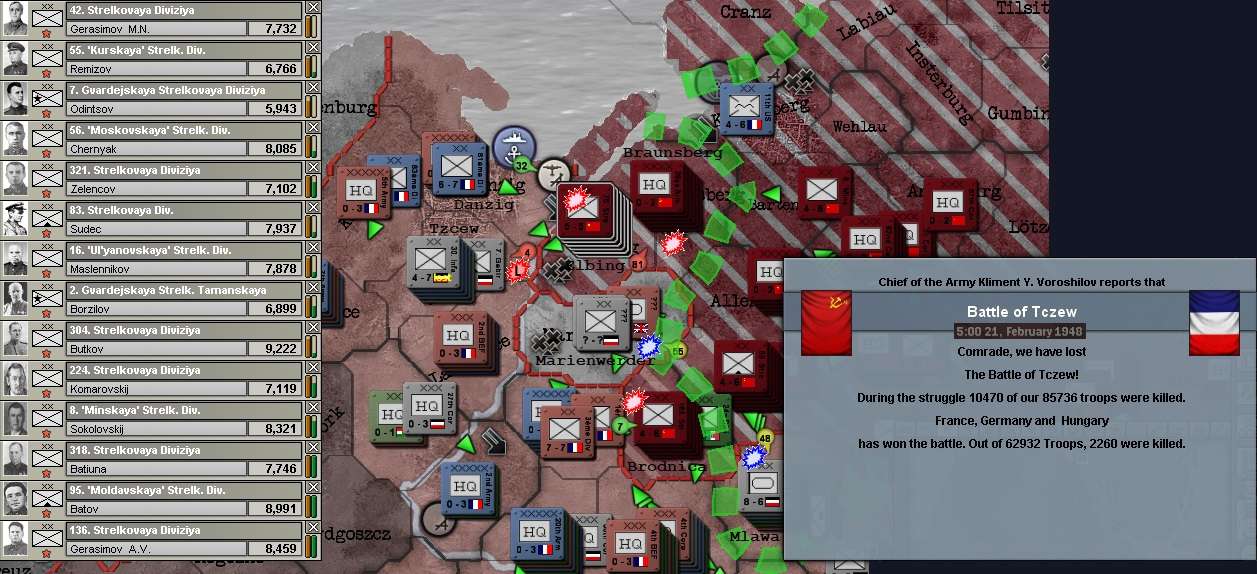
German attempts to raid Elbing again on 22, 23 and 24 February were beaten off, but early on 25 February the latest outnumbered Soviet attempt to retake Mlawa was defeated heavily (Soviets 4,328;/25,985; Allies 3,767/84,758 killed). That was followe dup almost immediately by a new large Allied attack on Brodnica with a mix of German, French, Italian and Czech troops.
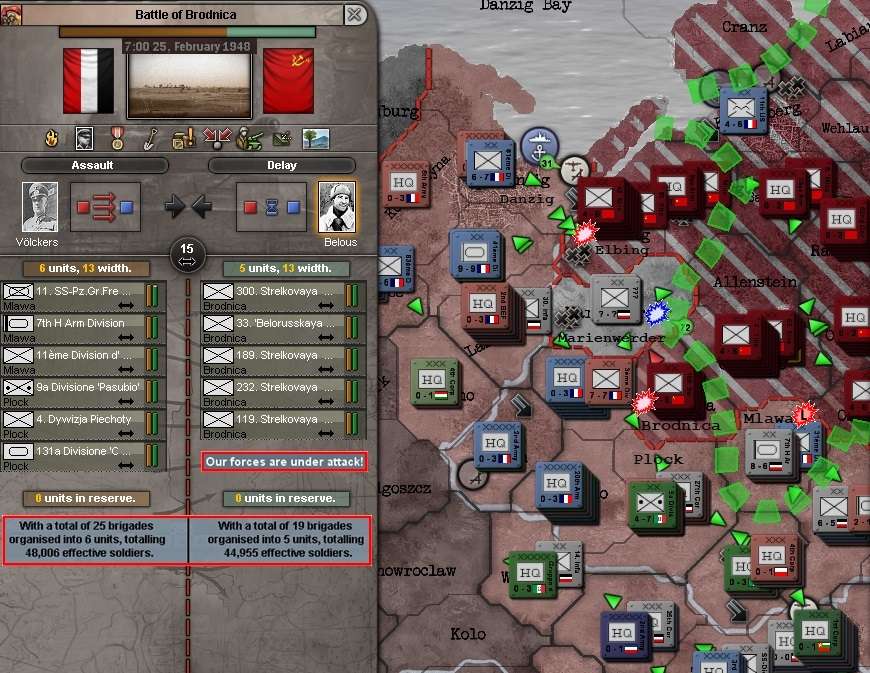
Good news came at 0100hr on 26 February with an expensive but important victory in the attack on Marienwerder (Soviets 4,190/125,683; Allies 3,377/40,128 killed). Balanced the next day at 0600hr with news of defeat in hard-won Brodnica (Soviets 4,448/44,955; Allies 2,730/86,988 killed).
The concentration of battle casualties, air raids and aerial engagements across the Prussian-Polish Sector in February showed where the fighting had been fiercest, with each side making a few limited gains in key areas where breakthroughs were contained. It was really starting to resemble WW1 rather than WW3 on the front line, even if nuclear weapons launched in the Allied rear had seen a different order of destruction.
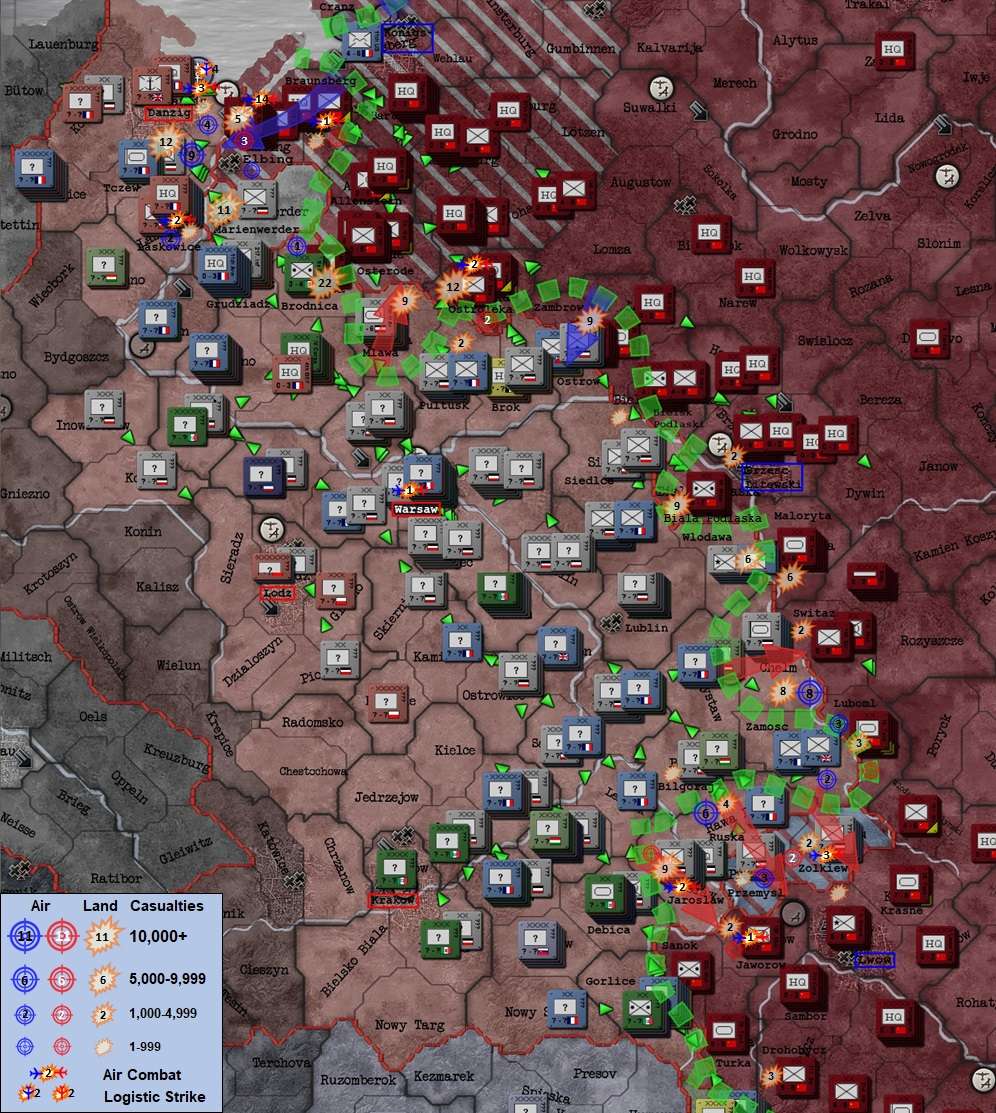
******
5b. Romania
The month began with an active nest of French and Hungarian wings operating out of Debrecen against targets in Romania, where the air base had been fully repaired (4.0). An SS-6 strike at 1000hr on 1 February soon sorted that out, destroying the base facilities and runways all over again.
By mid-month, the Allied offensive had penetrated all the way to the Soviet border, where local commanders, with STAVKA ‘assistance’, were desperately trying to establish a defence along the natural obstacle of the Dniester River. Air power had been used heavily to try to blunt the offensive, but was not enough alone to stop the Allied advance. The big, powerful French armoured divisions were particularly hard to stop.
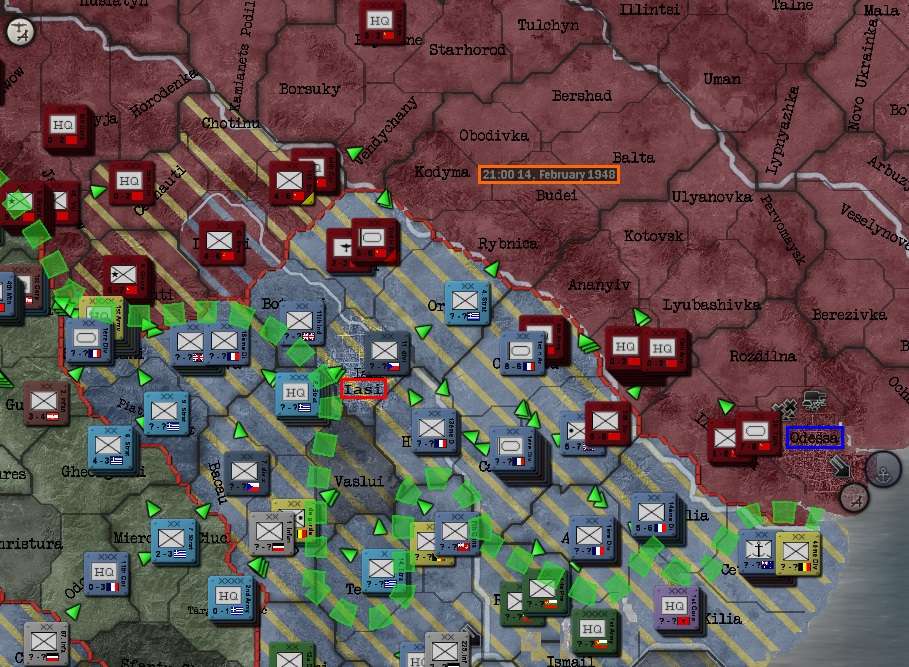

Czech troops would then reinforce Rybnica before the Soviets could reoccupy it and had to be fought again on 21 February. The province was finally secured before the end of the month.
Throughout this period, Balti was assailed relentlessly by the VVS in an attempt to wear down a heavy concentration of Allied formations: from 14-28 February, VVS raids caused an estimated 15,800 Allied ground casualties. Occasional Allied efforts to intercept the raids were generally beaten off successfully. Heavy air battles continued over Radauti for a few days and less so over Cernauti (both of which were briefly lost and regained during the month), as was Vendychany on the east bank of the Dniester.
The map of engagements during February illustrates the steady flow of the Allies across eastern Romania and where the Soviets managed to halt and in some places turn back the advance. On the map below, blue flags represent provinces taken by the Allies during the month but regained by the Soviets before it ended. The red flags indicate Allied attempts to cross the Dniester that were hurled back by the defenders. An uneasy line was holding for now, but remained vulnerable to increased Allied pressure until it could be further reinforced.
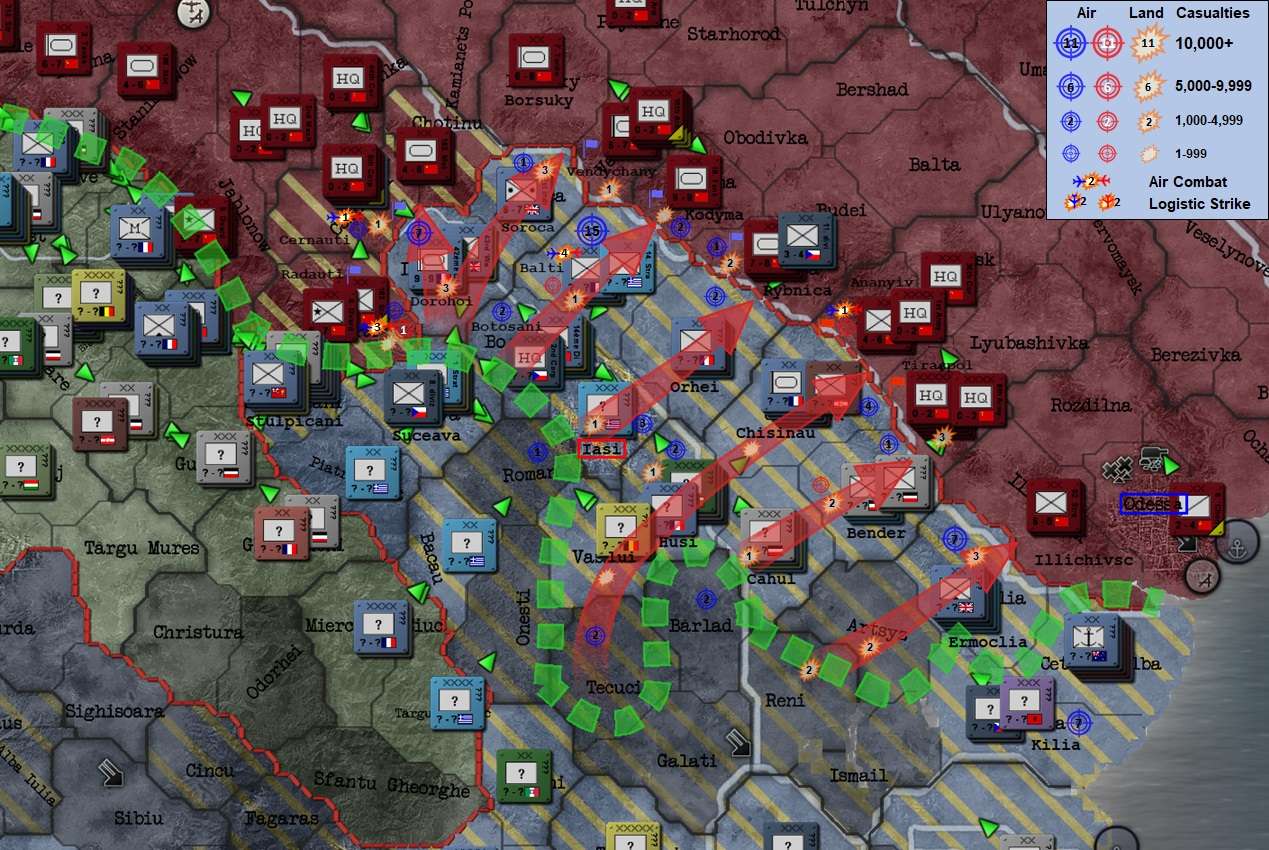

******
6. Research
Research projects didn’t start to mature until 18 February, after which nine were finalised in a rush – with some increases to the upgrade bill resulting, including for the next generation of jet engines. Artillery and AT development had become a priority, while the latest rocket engine advance was balanced by starting research on increasing their payload.
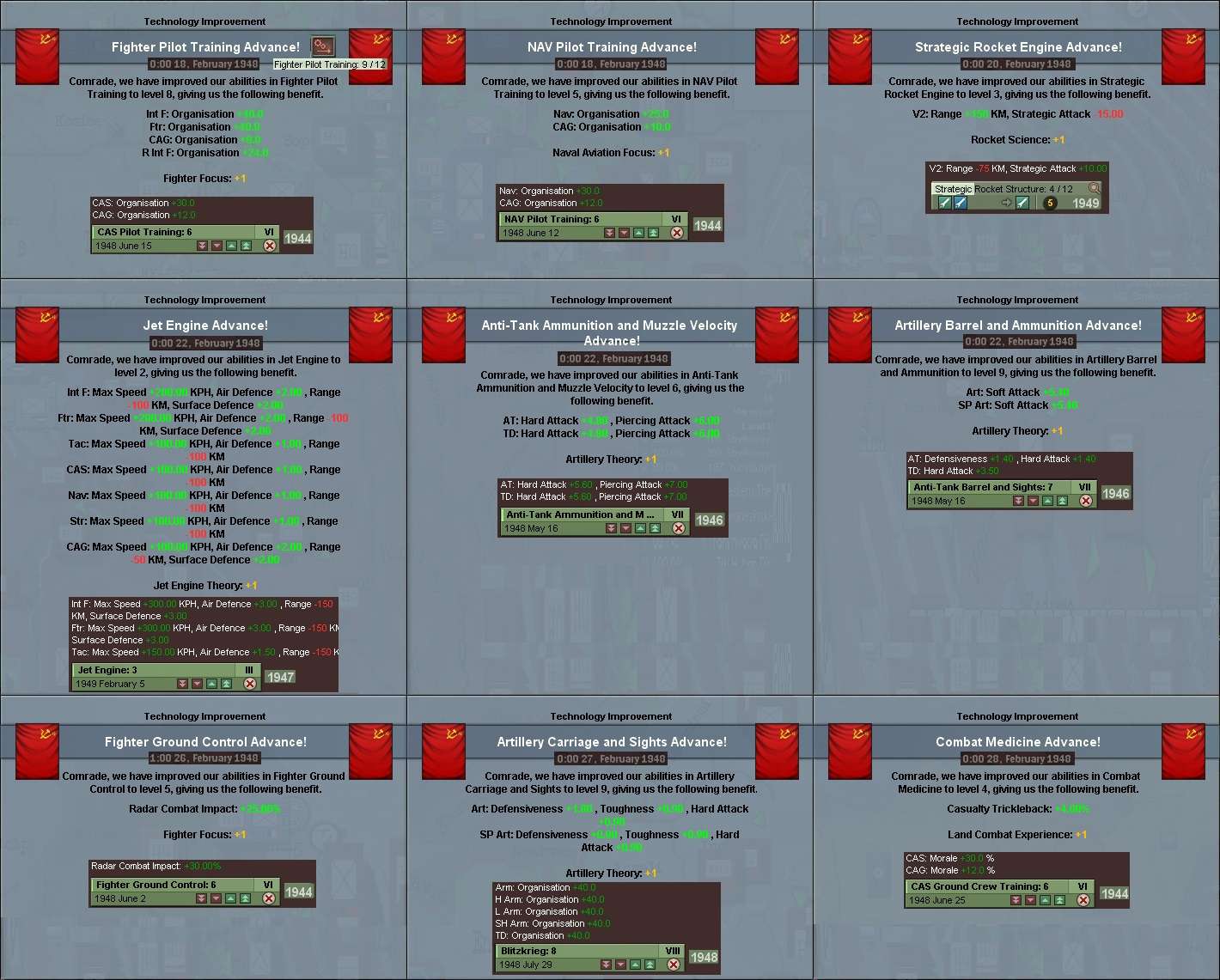
******
7. Industry and Strategic Warfare
The month started with the supply stockpile hovering at around 43,800. With the Soviets keen to get the upgrade program going strongly again, so on 1 February upgrade expenditure was maxed once more, production kept capped at 60 IC, while reinforcements continued to be maxed. The effect would be gauged with the aim of not letting the supply stockpile fall below 30,000.
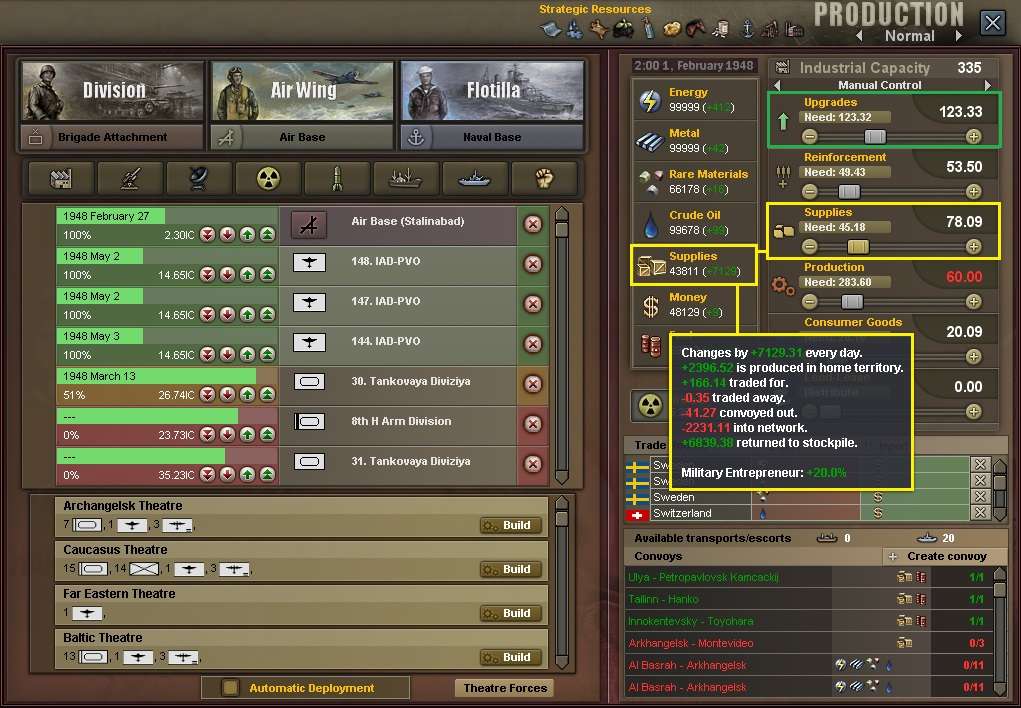
The RAF’s strategic bombing campaign resumed on 3 February and continued through to the 6th. With the scratch fighter group recovering in Sevastopol up to base operational status, at 0800hr on 6 February it was ordered to patrol on a ‘cone corridor’ to cover as many of the RAF’s targets as possible.
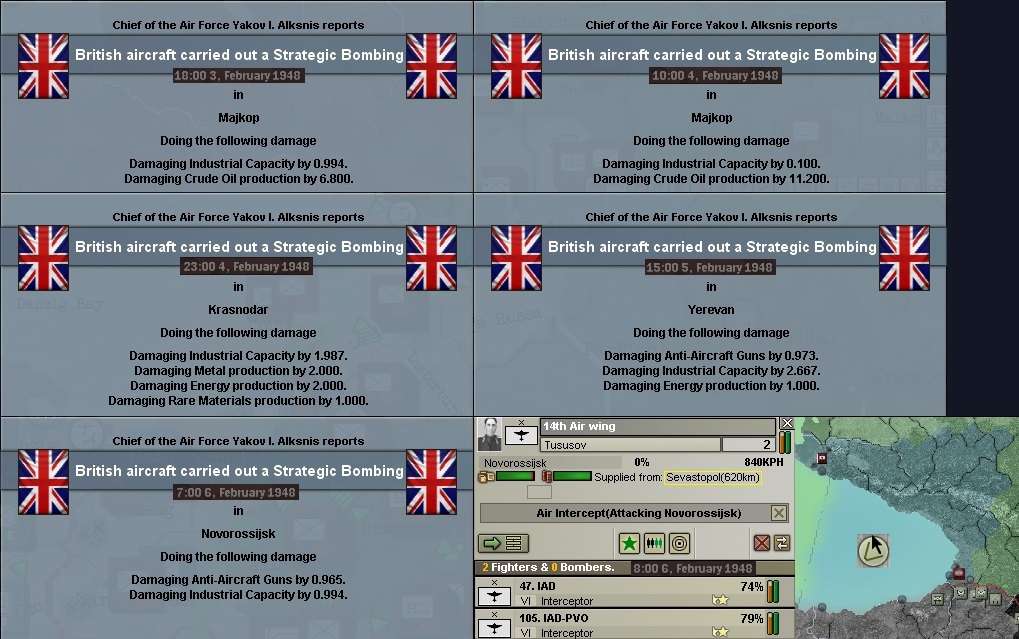
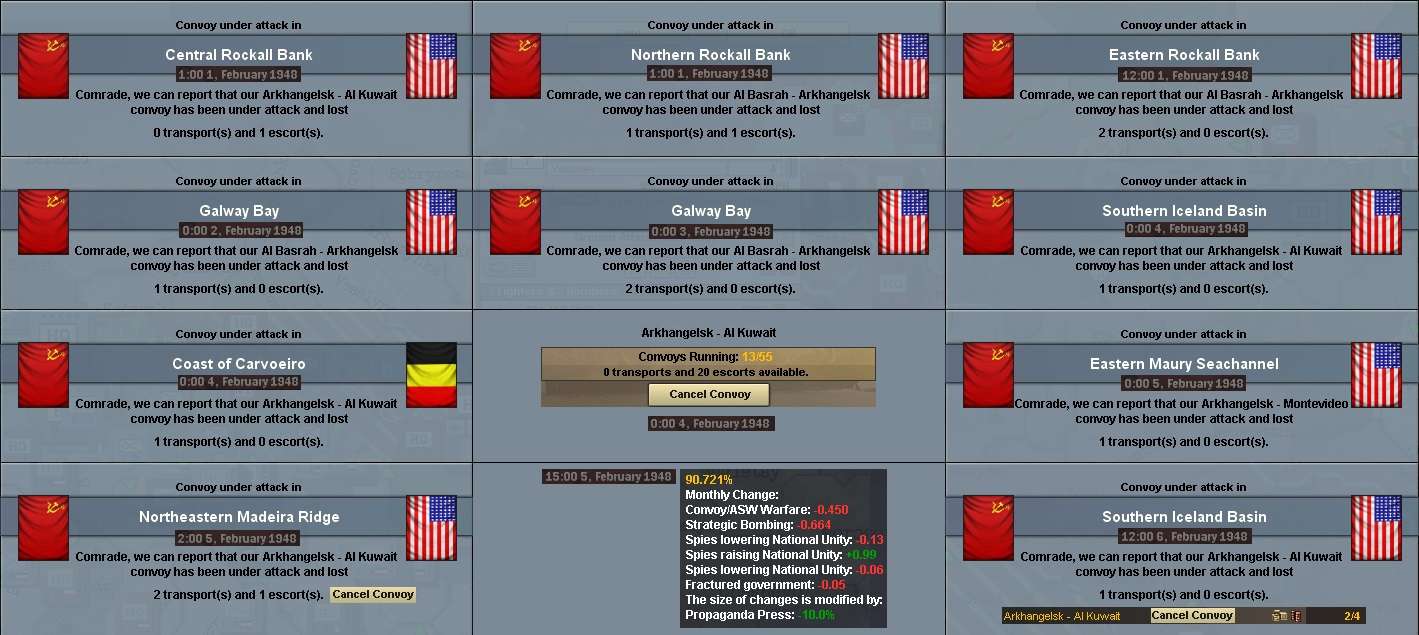

By 10 February the supply stockpile was still decreasing, but remained above 35,000. Production had been inched up to 65 IC to account for the recent new projects, upgrades were at 77/99 IC, supply inched up to 105 IC. Reinforcements were demanding about 60 IC.
On 18 February, the RAF sent a tactical bomber group through the Black Sea to an unknown target (unclear whether they were transiting or on a bombing mission): but the Sevastopol VVS INT detachment found them, evading their escorts to practically destroy one TAC wing as they were chased from the Coast of Abkhazia to the Central Black Sea that night.
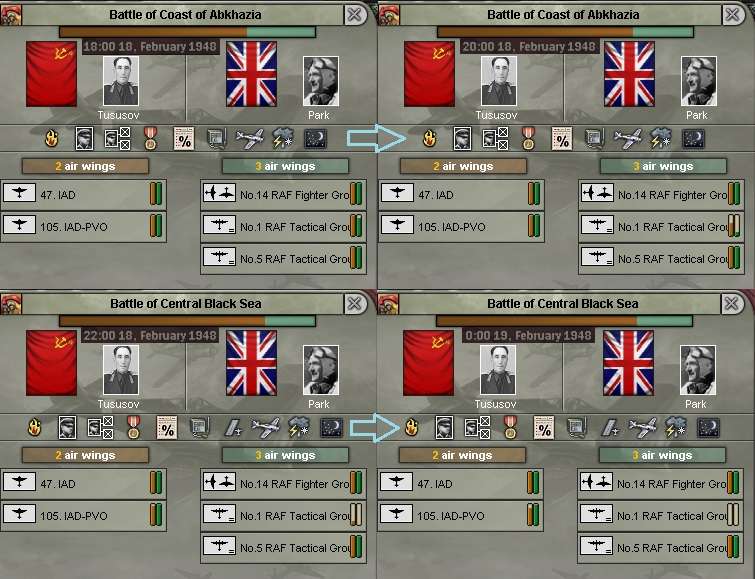
By 23 February, with the supply situation roughly stabilised at just 57 IC and new upgrades required (including new jet engine retrofits), the upgrade allocation was maxed back to 117 IC. Reinforcements were up to 73 IC and production kept at around 66 IC, with the missile batteries placed at the top of the queue, temporarily relegating some new armoured divisions to ‘below the line’.
And the Soviets were still trying to stop unauthorised convoys, especially on the Archangelsk-Al Kuwait supply and fuel route. [I thought, perhaps this time I will get it to stick by keeping the convoy on but zeroing out the commodities instead. But no, a new one popped up anyway. There must be some setting I can tick to stop it! Hmmm.]
From 8-28 February, the rate of convoy destruction slowed, but another 14 transports and six escorts were lost.

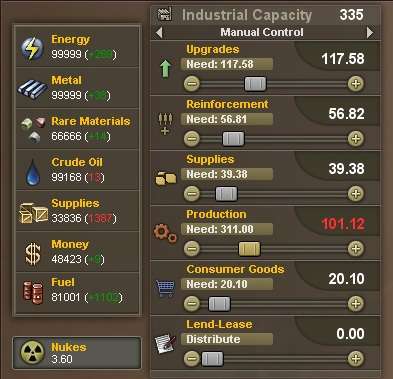
******
8. Espionage
With things now relatively quiet for Soviet agents in both Turkey and Spain, the Spanish mission was also changed to 100% covert operations on 5 February. By the end of the month, Allied spy activity in the USSR had increased almost back to pre-war levels, with the UK, US, Germany and Italy having half the spies caught shared between them.
There had been just one Soviet spy lost in Spain. Despite no active Soviet agitation, the Communist party support in Spain had rocketed up to 26% and increased slightly in Turkey to 17%. The groups of covert teams in both countries had increased healthily. The plan remained for the effort to switch back to political agitation once enough local covert operatives were in place to launch a coup, the timings of which would be determined based on circumstances.

- 6



